

Sacred Ground (episode)
- View history
- 1.2 Act One
- 1.3 Act Two
- 1.4 Act Three
- 1.5 Act Four
- 1.6 Act Five
- 2 Memorable quotes
- 3.1 Story and script
- 3.2 Cast and characters
- 3.3 Production
- 3.4 Continuity
- 3.5 Reception
- 3.6 Video and DVD releases
- 4.1 Starring
- 4.2 Also starring
- 4.3 Guest Stars
- 4.4 Uncredited Co-Stars
- 4.5 Stunt doubles
- 4.6 References
- 4.7 External links
Summary [ ]
The crew of the USS Voyager accepts an invitation from a humanoid race called the Nechani to take shore leave on their planet . To learn more about the Nechani culture, several of the crew members take a tour of some of the Nechani religious sites and caverns. Curious about a particular shrine, Kes attempts to enter it and is knocked unconscious by a biogenic field at the entrance.
Act One [ ]
B'Elanna Torres and Harry Kim quickly transport Kes to sickbay and demand to know more about the shrine, and are anxious to remain on the planet to analyze the field and gather information that may be able to revive Kes from her comatose state. However, the Nechani feel that Kes is being punished by the Ancestral Spirits for inappropriate behavior. They state that there is simply nothing that can be done about it.
The Doctor stabilizes Kes and determines she's undergone severe neuroleptic shock and is in a kind of coma . He will need more information about what happened before he can treat her. Captain Janeway must try the diplomatic route and talk to the Magistrate while Torres and Kim scan the area from the ship. Neelix insists on helping, so she has him find information on the shrine in their records.
Her pleas to the Magistrate to let them back to the surface so that they can take some scans of the shrine in order to find answers to Kes' condition are rejected. He claims further he is not a spiritual leader, and does not know why the spirits do what they do. Unfortunately, those that do, the Nechisti Council , consider the matter closed.
Back in sickbay, The Doctor unfortunately must tell Janeway that he has no answers, and the ship's scans can't be clear through the rock. Fortunately, Neelix has some information in the form of a story about a king, Nevad , whose son made the same error as Kes: To save his son, this king decided to undergo the ritual that the monks endure in order to enter the shrine without harm. The king was successful with his plea and able to see his son awaken from his "death sleep." Janeway decides to try this approach in order to covertly gather scientific data about the shrine. She tells the Magistrate what she's found, and insists that she can claim the same kind of relationship Nevad had and go through the same ritual.
Act Two [ ]
Janeway prepares for the ritual, fully not expecting to talk to spirits, but rather some kind of physiological change as a result of some physical test of endurance, by reviewing these kinds of rituals in the Federation database . Chakotay notes to have some precautions ready, but also reminds her that maybe the Spirits really do exist there. Just then, the Magistrate has called in with an answer: The Council is fascinated by Janeway's proposal and eagerly awaits to help her. He adds that he is deeply troubled by what's happened, and will be very pleased if it is successful.
The Doctor and Kim have prepared an implant to monitor Janeway's biological readings and help the transporter to lock on to her if needed. Tuvok offers a phaser , but Janeway would rather not appear hostile.
A guide meets Janeway at the entrance to the cave at sunset. She is seemingly friendly, though tricks her into giving her the tricorder . She brings her to a few others who change her clothes into a robe and give her markings on her skin. Interestingly, the guide says she does not know what happens in the ritual, but cryptically says she will guide her through it. Then, she leads her to a room full of elderly people who invite her to join them as they wait. When she asks them how long they've waited, they squabble and bicker among themselves, and, oddly, reply that they have been waiting for as long as they can remember.
Act Three [ ]
Janeway doesn't understand the comment, as she's seen young monks there, so they haven't been waiting that long. She grows impatient, not planning to wait for half an eternity, and tries to open the other door. The guide answers, and allows her to leave. She leaves the room – eager to begin the challenges that might lead to a cure for Kes. Her guide informs her that everything she does during this ritual will be meaningless, and that the only thing that matters is finding her connection to the spirits. Yet Janeway is eager to go through each of the physical challenges imposed on her – believing them to be the key to a cure for Kes. The guide asks her to hold a rock and Janeway tells her what she sees.
Meanwhile, on Voyager , The Doctor is monitoring the readings, but so far nothing jumps out. As Janeway is next asked to finger-paint freely and then rock-climb, she becomes increasingly exhausted from the physical exertion. The Doctor then sees her neuropeptide levels rise to an abnormal level, possibly creating a natural barrier to the biogenic energy.
Finally, she is asked to place her hand inside a container that houses a hissing creature called a nesset ; it bites her, and she soon feels hot and falls unconscious. She wakes in a kind of hole, and states she is dying. The guide simply replies "everyone dies eventually" and the doors close.
Act Four [ ]
Chakotay is getting impatient, and considers going down to get her, but The Doctor insists he sees no reason for alarm. Further, he's getting more interesting data on what's happening, particularly from a certain amino acid which is changing the flow of neurotransmitters to create an hallucinogenic effect . However, she is conscious and capable of signaling them via the implant if she chooses. Chakotay has a hard time believing it, but, as Tuvok points out, she would want to complete the ritual.
Janeway finds herself on a seashore, where her guide ostensibly acts as the voice of the spirits, who tell her that her request to have them reawaken Kes is inconsequential as Janeway possesses all the information she needs to help Kes. She relates what happened to the guide, and she gives her back her uniform .
Janeway returns to Voyager confident that she finally got all she needs to help Kes. The Doctor seems equally confident, believing that the immense amount of data gathered can be utilized to find a cure. He states that the toxin from the creature's bite appears to have been the key, for it creates a biochemical immunity to the energy burst that hit Kes. He has a treatment prepared and is ready to use it on Kes. Strangely, although the 'cure' works and restores her biochemical levels to normal, Kes still doesn't wake up and the Doctor is forced to discontinue the treatment to avoid causing internal damage. He tells Janeway that everything she went through was 'meaningless'.
Janeway returns to the planet to question her guide; after all, she did everything that the guide told her. But the guide tells her that she in fact didn't lead Janeway anywhere, for this was Kathryn's ritual: she herself set these challenges, the guide simply fulfilled Janeway's expectations as Janeway would have simply settled for nothing else. Janeway admits that when she started the trial she had some preconceptions about what it would involve, but now she doesn't know what she is seeking but still won't give up. The guide tells her that now she is finally ready to begin.
Janeway returns to the waiting room, where the elderly people greet her again.
Act Five [ ]
Now, Janeway asks more from these people about what she's supposed to accomplish in the room. They in turn derisively banter about her reliance on reason. They know that she is the kind of person who believes that she will eventually find the answers to Kes' situation with enough time, study and the right sort of tools. After all, that is what she believes as a scientist , even when her science fails right in front of her eyes. Janeway acknowledges that she is willing to try another path if science doesn't work, so they tell her to take Kes through the energy field again, to kill her. They can't tell her what it will do because the biogenic field, according to Voyager 's scans, is lethal. They ask her, however, to let go of all her beliefs about the facts and simply trust the spirits to return her soul. If she believes she is ready, she is. But if she goes in with any doubt, with any hesitation, they will both be dead.
Janeway orders Commander Chakotay and Neelix to beam Kes back to the shrine. There, Chakotay realizes she intends to take Kes back into the field, in the belief that it will awaken her. Chakotay reiterates the uncertainties and asks for more time for scans, enough to the point where he's considering declaring her unfit for command. Janeway says she can't explain it, but she now believes it. So she carries Kes through the field, where a burst of energy hits them. However, they remain unharmed and Kes finally awakens.
Later, in sickbay , The Doctor goes into elaborate detail and gives a plausible scientific explanation for why taking Kes through the biogenic field again, combined with the ritual Janeway went through and the toxin released into her body saved Kes' life. Janeway nods and listens – somewhat absentmindedly – to The Doctor's explanation, stating that it is indeed very plausible and scientific. Yet she walks out of sickbay unsure really whether it was the science or her faith that was at work here.
Memorable quotes [ ]
" We aren't going to stand by and do nothing." " There's nothing you can do, she's been punished by the spirits, she's going to die. "
" I don't suppose you know anything about chromodynamic light, do you? " " No, not really. I suppose I could look at it. " " That device you've got, what is that? " " It's called a tricorder. … it's a scanning device. " " Aah, atmospheric readings, energy field analysis, full technical data base. This is certainly a convenient thing to have. " " I'll need that back. " " No, you won't. " " You're my guide. "
" I'm sure there is spiritual significance behind the challenges involved. " " Challenges? That's what you expect. " " I don't have any idea what to expect. " " I'm willing to do whatever is necessary. " " I don't doubt that. But do you realize that all of this is meaningless? "
" Your request is inconsequential. You have what you need to save her yourself. "
" I haven't led you anywhere, Kathryn. You've taken me along wherever you wanted to go. This was your ritual. You set these challenges for yourself. " " It's true that I came here with certain expectations. Are you saying that you simply fulfilled my expectations? " " You'd have settled for nothing else. "
" A test? She thinks we're a test! What is she talking about? " " She must like tests. I suppose tests make sense to her. "
" Even when her science fails right before her eyes she still has full confidence in it. Now there's a leap of faith. "
" Let all of that go, Kathryn. Take Kes back into the shrine and trust the spirits to return her soul. " " The ritual I went through was meaningless and Kes has done nothing to prepare herself. How could either of us be ready to go through the field? " " If you believe you are ready, then you are. There's no more to it than that. But if you go in with any doubt, with any hesitation, then you're both dead. So, what are you going to do, Captain? " " You know I won't stand by and watch Kes die if there's anything I can do to save her. I want to believe it's possible. I'm going to try. "
" I don't know about this, Kathryn. " " Neither do I. That's the challenge. "
" Captain? If there's something about my analysis you disagree with…? " " lt's a perfectly sound explanation, Doctor. Very… scientific. "
Background information [ ]
Story and script [ ].
- The predicament in which Janeway found herself in freelance writer Geo Cameron 's plot concept, which provided the basis of this Star Trek: Voyager installment, was what appealed to Voyager 's writing team so much that they bought this episode's story. Staff writer Lisa Klink explained, " That story was pitched by a freelancer named Geo Cameron. We took the concept, Janeway going through this ordeal that kind of forces her to deal with things in a non-scientific fashion, because that seemed like a very interesting thing to do to her character. " ( Cinefantastique , Vol. 29, No. 6/7, p. 95)
- Lisa Klink thereafter struggled with the writing of the installment's teleplay. " It was tricky, " she admitted, " because obviously it was very talky, and philosophical, and you really had to pay attention to keep up with what was going on. That was one of the harder scripts that I've ever written. " ( Cinefantastique , Vol. 29, No. 6/7, p. 95)
- The episode's final script draft was submitted on 5 March 1996 . [1]
- In summation of the episode's theme, Lisa Klink remarked, " The point of the episode is that you can't explain everything. That's really what faith is about. " ( Cinefantastique , Vol. 29, No. 6/7, p. 95) The spiritualism that Klink attempted to imbue the episode's script with was obvious to other members of production personnel, including supervising producer Brannon Braga and director Robert Duncan McNeill . Braga once jokingly referred to this episode as "kind of A Man Called Horse with Janeway," adding, "she has a spiritual journey." ( Star Trek Monthly issue 20 ) Robert Duncan McNeill described the episode as "an extremely spiritual show about Captain Janeway having to let go of logic, take a leap of faith and consider the magical, mystery, godlike elements of the world." ( Star Trek 30 Years , p. 48) McNeill also commented, " It's the kind of episode that's very much a thinking person's, moody piece. It's not a big shoot 'em up. It's a story of ideas, of feelings, of character journeys. " ( The Official Star Trek: Voyager Magazine issue 11 ) In addition, McNeill said of the episode, " It had a real spiritual kind of story–a real character-driven story. It wasn't a big action show. " ( Cinefantastique , Vol. 29, No. 6/7, p. 107) McNeill also felt that this episode presents no easy answers. " It kind of leaves it up to the viewers and to the characters to contemplate, and decide what they think about faith and religion, " he related. " It's a very different kind of show for Star Trek . It's almost like an X-Files show. It sort of presents two answers – one is a scientific solution and the other is a mystical solution – and it doesn't say one way or another. " ( Star Trek Monthly issue 20 )
- The degree of uncertainty about this episode's teleplay extended to the production personnel. " On the page, everyone kind of questioned it, " Robert Duncan McNeill recalled. " Everyone thought, 'Is this gonna work? There's no action in it. It's all Janeway by herself. We don't have the other guys doing much.' " ( Star Trek Monthly issue 28 , p. 59)
Cast and characters [ ]
- Regarding how this episode tasks Janeway with taking a leap of faith, Robert Duncan McNeill commented, " As a scientist, this is not easy for her to do. " ( Star Trek 30 Years , p. 48) Likewise, Lisa Klink mused, " [Janeway] is someone who has great faith in the ability of science to explain everything. This is kind of a reminder to her that there's a lot of really weird stuff out there in the universe. It's just a question of keeping an open mind and allowing herself to just accept some things without being able to actually pin it down, and scan it, and measure it, and explain it all in a nice little burst of technobabble . " ( Cinefantastique , Vol. 29, No. 6/7, p. 95) Janeway actress Kate Mulgrew noted about her character's spiritual journey here, " Janeway went through a lot in that one. " ( The Official Star Trek: Voyager Magazine issue 14 , p. 32)
- As Robert Duncan McNeill had a very good relationship with Kate Mulgrew, he was pleased that she was the central performer of this episode. He commented, " I was thrilled that she had the story for [this] episode. We have such a great relationship. We were able to discuss the scenes in more depth than the average directors might. " McNeill was also delighted by Mulgrew's acting in this installment. " I thought it was one of Kate's best performances, " he noted. ( Cinefantastique , Vol. 29, No. 6/7, p. 107)
- Kate Mulgrew herself counted this as one of her favorite installments of Star Trek: Voyager 's third season. ( The Official Star Trek: Voyager Magazine issue 14 , p. 32)
- Robert Duncan McNeill appears in his usual role of Tom Paris in this episode, but he has no lines of dialogue.
- B'Elanna Torres appears only briefly in this episode. Actress Roxann Dawson recalled, " I had about 30 seconds of screen time in 'Sacred Ground.' " ( The Official Star Trek: Voyager Magazine issue 12 )
- Robert Duncan McNeill thought highly of the supporting characters and the guest performers of this installment. He opined, " It had a lot of wonderful characters in it. It had great guest stars. " ( Cinefantastique , Vol. 29, No. 6/7, p. 107)
- Guest star Harry Groener (the Nechani Magistrate ) previously appeared as Tam Elbrun in TNG : " Tin Man " and would go on to feature as Minister Nathan Samuels in the Star Trek: Enterprise two-parter " Demons " and " Terra Prime ".
Production [ ]
- This episode was the first (in production order) of four episodes that were produced during Voyager 's second season but intentionally held back for inclusion in its third season , the other episodes being " False Profits ", " Flashback " and " Basics, Part II ". ( Star Trek: Voyager Companion (p. ? ))
- This was the first Star Trek episode directed by Paris actor Robert Duncan McNeill. He had first approached executive producer Rick Berman about directing in March 1995 , after which McNeill had studied the various aspects of production on Star Trek , visiting the Paramount Pictures lot even on days when he had not been playing Tom Paris. ( Star Trek 30 Years , p. 48)
- The task of directing this episode was originally assigned to Jonathan Frakes . Robert Duncan McNeill noted, " Frakes […] backed out in order to direct Star Trek: First Contact – so they gave his slot to me. " ( Star Trek 30 Years , p. 48) McNeill also explained, " What happened was Jonathan [Frakes] was scheduled to direct an episode of the show and when he was offered the feature he had to step out and couldn't direct an episode for us. When I heard that I thought about it long and hard and went to Rick with my list and said, 'Here is what I've done and I think I'm ready. I don't have any expectations, but I want to get on the list of people to take that spot.' That was the only [episode] available, everything else was booked up. We had a good conversation and I walked away feeling that he did believe that I was ready. " ( Cinefantastique , Vol. 28, No. 4/5, p. 94)
- Privately, however, Robert Duncan McNeill believed that the episode he would be asked to direct would not be this one, but one produced in the third season. " I didn't really expect to get the episode, " McNeill remembered. " I was pushing that one thinking I would get one early next season. " ( Cinefantastique , Vol. 28, No. 4/5, p. 94)
- On a weekend day – one or two weeks after requesting this episode, and almost a year to the day of his original discussion with Rick Berman – Robert Duncan McNeill was appearing as a guest at a Star Trek convention in either Cincinnati or Cleveland when he received, indirectly, word from Berman (who wanted to speak to him about this installment, although McNeill had no way of knowing that, at the time). ( The Official Star Trek: Voyager Magazine issue 11 ; Star Trek 30 Years , p. 48; Cinefantastique , Vol. 28, No. 4/5, p. 94; Cinefantastique , Vol. 29, No. 6/7, p. 107) While checking out of a hotel, McNeill received an emergency message to call his wife, who – when he did – told him that Berman had called that morning and wanted McNeill to phone him back as soon as possible. McNeill's wife was distraught, as she suspected the news was that her husband had been fired. " She said, 'Why would he call on a weekend unless there's something really wrong?' I said, 'OK, don't worry. I'll call him now and I'll call you right back.' So, I did, " McNeill recalled with a laugh. " Rick said some things in scheduling had gotten a little screwy and there was a directing slot available in two weeks, was I ready to start? I said, 'Absolutely.' I didn't have much time to get nervous. " ( The Official Star Trek: Voyager Magazine issue 11 ) McNeill additionally remembered, " He called me […] to say that they had a meeting about it and wanted to give me the shot. " ( Cinefantastique , Vol. 28, No. 4/5, p. 94)
- The imminence of the episode's production start date somewhat flustered Robert Duncan McNeill, even though he was simultaneously happy to have been given the directing assignment. " It was about a week or two from shooting, at that time, so I wasn't prepared for it initially, " he remembered. " I hadn't expected to direct quite that quickly, or have an assignment with such short notice, but I was really thrilled. " ( Cinefantastique , Vol. 29, No. 6/7, p. 104)
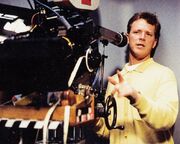
Robert Duncan McNeill during production on this episode
- Working on this episode was a definite learning experience for Robert Duncan McNeill. Regarding his level of preparation when he came to direct the episode, he recalled, " I had every shot in my book, everything planned. " However, he added, " I learned from directing ['Sacred Ground'] that there are some things you just can't plan. " ( Star Trek Monthly issue 27 , p. 14)
- Due to this episode being so character-driven and introspective, Robert Duncan McNeill found that dramatizing the mental processes of the characters was challenging. He commented, " It's not an action show which is a blessing and a curse for me actually […] Logistically, action shows are very complicated, but because this is a real internal story for Janeway, it became more of a challenge how do you make these thoughts and ideas and philosophy more dramatic? " ( Cinefantastique , Vol. 28, No. 4/5, p. 94)
- Another difficulty for Robert Duncan McNeill was tackling the episode's unusual ambiguity. " It was a very tricky episode, " he said, " because [although] Star Trek usually ends their stories with a nice moral and a nice lesson to learn […] this story explores religion and faith without offering any clear answers at the end. " ( Star Trek Monthly issue 20 )
- Robert Duncan McNeill took contributions from all involved. " Everybody contributed, " he said. " I tried to incorporate everyone's ideas. " ( The Official Star Trek: Voyager Magazine issue 11 )
- The task of directing the episode was such that Robert Duncan McNeill felt no need to embellish the installment with any elaborate camera work. " I don't have any outside agenda other than to tell this script that they have given me as best as I can. I don't think there are any sort of old thoughts that I've had that now that I have a chance I can throw this in, " McNeill conceded. " It's enough work just to tell the story they have given me, much less squeeze in my own thing. All I want to do is make it as exciting a show as I can to keep the audience there. " ( Cinefantastique , Vol. 28, No. 4/5, p. 94)
- Ultimately, Robert Duncan McNeill believed that the uncertainty concerning the episode's script was made up for, during production. He commented, " Sometimes, an episode that reads very weak on the page makes you work that much harder, and therefore you end up with a better episode […] I saw [something similar] as a director on 'Sacred Ground' […] It wasn't a shoot-em-up show, but everybody focused and tried to fill out every moment of that episode, and it paid off. " ( Star Trek Monthly issue 28 , p. 59)
- Roxann Dawson, Kate Mulgrew and Lisa Klink were wowed by Robert Duncan McNeill's work on this installment. Dawson noted, " I was impressed with what Robbie did. " ( The Official Star Trek: Voyager Magazine issue 12 ) Mulgrew stated, " I thought Robbie McNeill did a very nice job directing [it]. " ( The Official Star Trek: Voyager Magazine issue 14 , p. 32) Klink agreed, " I thought he did a very nice job with it as well. " ( Cinefantastique , Vol. 29, No. 6/7, p. 95)
Continuity [ ]
- Despite being the 7th episode in this season, the stardate establishes the events of this episode as having occurred after the season premiere " Basics, Part II " but before the next five episodes (" Flashback ", " The Chute ", " The Swarm ", " False Profits " and " Remember ").
- When consoling Neelix, who is worried for the unconscious Kes, The Doctor says he does understand what it's like to feel helpless. This may be a reference to " Heroes and Demons ", where The Doctor has to watch his holographic love interest die from a sword wound.
Reception [ ]
- Ultimately, Lisa Klink was very proud of this episode in general. She noted, " I was very pleased with how it came out. " ( Cinefantastique , Vol. 29, No. 6/7, p. 95)
- Robert Duncan McNeill was also highly satisfied with the episode's final form. He remarked, " I thought it turned out to be one of our better episodes, because it was different. " ( Star Trek Monthly issue 28 , p. 59) He also noted, " I'm really happy with it. " ( The Official Star Trek: Voyager Magazine issue 11 ) Partly due to this – prior to the initial airing of Voyager 's third season – McNeill was hopeful that the episode would have a good viewer response. He remarked, " Everyone seems really happy with it so far, […] and I think it's a good show […] I'd love to direct some more episodes this season, so I really hope viewers like it. " ( Star Trek Monthly issue 20 ) Following his work on this episode, McNeill eventually directed three further episodes of Voyager (including the later third season installment " Unity ") and four of Star Trek: Enterprise , as well as other projects.
- This episode achieved a Nielsen rating of 4.6 million homes, and a 7% share. [2] (X)
- Executive producer Jeri Taylor thoroughly enjoyed this episode when she watched a rerun of it. A week later (on a Thursday in June 1997), she commented, " I happened to see 'Sacred Ground' just last week when it re-ran and I loved it. I just thought that it was everything that Star Trek should be; it was provocative and profound, and it said something, and it did unexpected things. I really think it worked. It is not the kind of episode that I think many of our core audience respond to, because it was very introspective. There was no action, there were no phaser fights, there was none of that kind of thing. It was a thoughtful kind of episode, but there's absolutely room for shows like that in the mix [of Star Trek: Voyager 's stories]. " ( Star Trek Monthly issue 31 , p. 12)
- Cinefantastique rated this episode 2 and a half out of 4 stars. ( Cinefantastique , Vol. 29, No. 6/7, p. 92)
- Star Trek Magazine scored this episode 4 out of 5 stars, defined as " Trill -powered viewing". ( Star Trek Monthly issue 25 , p. 60)
- The reference book Delta Quadrant (p. 147) gives this installment a rating of 7 out of 10.
Video and DVD releases [ ]
- UK VHS release (two-episode tapes, CIC Video ): Volume 3.4, 10 March 1997
- As part of the VOY Season 3 DVD collection
Links and references [ ]
Starring [ ].
- Kate Mulgrew as Captain Kathryn Janeway
Also starring [ ]
- Robert Beltran as Commander Chakotay
- Roxann Biggs-Dawson as Lieutenant B'Elanna Torres
- Jennifer Lien as Kes
- Robert Duncan McNeill as Lieutenant Tom Paris
- Ethan Phillips as Neelix
- Robert Picardo as The Doctor
- Tim Russ as Lieutenant Tuvok
- Garrett Wang as Ensign Harry Kim
Guest Stars [ ]
- Becky Ann Baker as a Guide
- Estelle Harris as an Old Woman
- Keene Curtis as Old Man #2
- Parley Baer as Old Man #1
- Harry Groener as The Magistrate
Uncredited Co-Stars [ ]
- Damaris Cordelia as Foster
- Tarik Ergin as Ayala
- Kerry Hoyt as Fitzpatrick
Stunt doubles [ ]
- Linda Madalone as stunt double for Jennifer Lien
- Lynn Salvatori as stunt double for Kate Mulgrew
References [ ]
adenosine triphosphate ; advisor ; amino acid ; Ancestral Spirits ; artist ; biochemistry ; biogenic energy ; biogenic field ; bio-scanner ; bloodstream ; Brother ; Chakotay's mother ; chromodynamic light ; combadge ; cortical stimulator ; data ; Delios VII ; dielectric effect ; doctrine ; electrolyte ; epidermal layer ; extensor muscle ; Federation ; fertility symbol ; guide ; hallucinogenic effect ; holodeck ; hour ; immunity ; iota ; iridium ion ; Janeway, Phoebe ; Karis Tribe ; king ; lactic acid ; lectrazine ; magistrate ; megajoule ; monk ; muscle strain ; Nechani ; Nechani homeworld ; Nechisti Council ; Nechisti shrine ; Nechisti Order ; neodyne light ; nesset ; neuroleptic shock ; neuropeptide ; neurotransmitter ; Nevad ; phenomenon ; physical conditioning program ; physiometric program ; plasma discharge ; poison ; psychoactive drug ; pulse ; purification ; respiration ; sanctuary ; shaman ; shore leave ; soul ; spiritual leader ; subdermal bioprobe ; spirit realm ; sunset ; synaptic pathway ; tarchee cat ; thoron radiation ; toxin ; tricorder ; vision quest
External links [ ]
- "Sacred Ground" at StarTrek.com
- " Sacred Ground " at Memory Beta , the wiki for licensed Star Trek works
- " Sacred Ground " at Wikipedia
- " "Sacred Ground" " at MissionLogPodcast.com , a Roddenberry Star Trek podcast
- 3 ISS Enterprise (NCC-1701)
- The Original Series
- The Next Generation
- Deep Space Nine
- Strange New Worlds
The Star Gazer
Project daedalus.

Sacred Ground
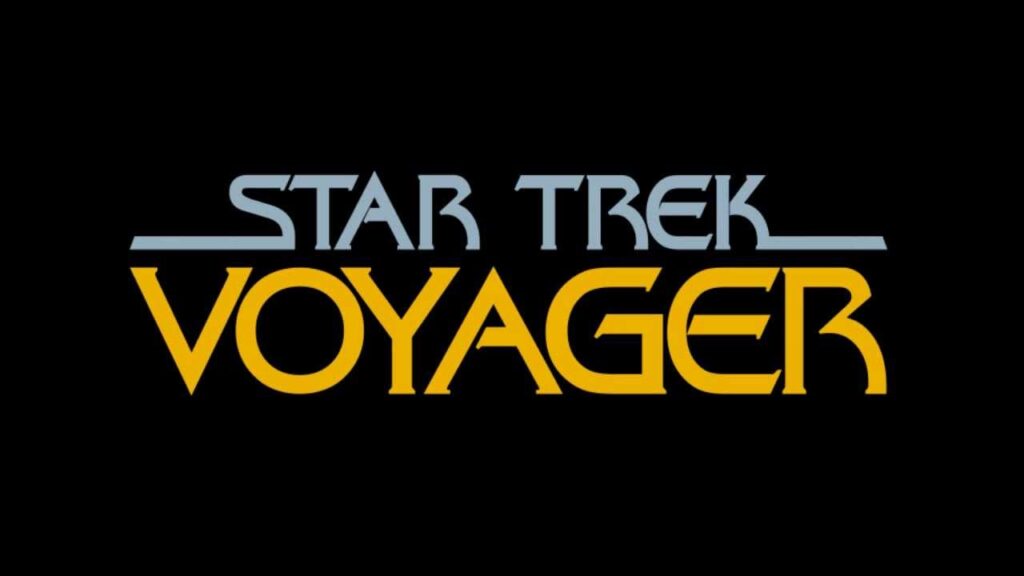
On an alien planet, Kes, a crew member of the USS Voyager, finds herself in a precarious situation when she enters a sacred temple to receive a healing ritual to save her life. After she’s refused entry, the Voyager’s Captain Janeway is forced to intervene and attempts to negotiate a peaceful solution. However, the local religion’s leader refuses to cooperate, believing that Janeway’s interference will bring disaster and destruction to their world.
In the meantime, Kes’ condition continues to worsen and her life hangs in the balance. With no other options available, Janeway and the Voyager crew must find a way to get her the healing ritual she needs without offending the local religion. The crew consult their holographic doctor, the EMH, to better understand the religious beliefs of the aliens and come up with a plan to save Kes.
As time runs out for Kes, Janeway is faced with a difficult decision: either risk offending the local religion and break into the temple to get the healing ritual, or let Kes die. With no other options, Janeway decides to break into the temple to save Kes.
Unfortunately, the temple’s priest is waiting for them and the crew find themselves in a tense standoff. Janeway and the priest, Krem, discuss the importance of respecting each other’s beliefs and come to a mutual understanding that the direction of the universe is determined by more than one faith.
Seeing that Janeway understands the importance of preserving their religious beliefs, Krem allows the crew to perform the healing ritual. The ritual is successful and Kes is saved.
In the end, Janeway and Krem form an alliance to protect the planet’s sacred ground and maintain peace between their two faiths. Through this experience, Janeway and the crew of the Voyager learn the value of understanding and respecting other cultures and beliefs. The crew also benefits from the alien healing ritual, which helps them to better understand their universe and the power of faith.
Related Posts
Equinox (part 2), persistence of vision.
Type above and press Enter to search. Press Esc to cancel.
- Show Spoilers
- Night Vision
- Sticky Header
- Highlight Links

Follow TV Tropes
http://tvtropes.org/pmwiki/pmwiki.php/Recap/StarTrekVoyagerS3E7SacredGround
Recap / Star Trek Voyager S 3 E 7 "Sacred Ground"
Edit locked, this episode provides examples of:.
- Beleaguered Bureaucrat : The poor Magistrate is clearly having a rough time threading the needle between the religious monks and the visitors from Voyager. He blames himself for what happened, and when Neelix manages to find an obscure historical precedent which will let Janeway try and save Kes, he's happy to advocate it to the monks.
- Bridal Carry : Janeway carrying a comatose Kes into the shrine.
- Buried Alive : Janeway is sealed inside a sarcophagus for a Commercial Break Cliffhanger . Janeway: I'm dying. Spirit guide: Everyone dies eventually. (lid slides shut)
- Cliffs Of Insanity : Janeway is climbing huge cliffs with the requisite Climb, Slip, Hang, Climb ...then we cut back to her holding the stone, as it's all an illusion.
- Curiosity Killed the Cast : Kes gets a near fatal injury when she insists on peeking into a sacred shrine that turns out to be protected by Some Kind Of Forcefield .
- Doing in the Scientist : Much of the episode is about Janeway putting aside her normal dependence on science and turn to understand religion. Despite all logic and evidence saying it shouldn't work, she is compelled to take Kes into the force field with her as an act of faith. Miraculously, Kes wakes up. After the fact The Doctor develops especially complicated Techno Babble to explain what happened, but Janeway's response makes her feel like he is discarding the faith she required .
- Don't Think, Feel : The three elderly supplicants urge Janeway to stop analysing everything and take a Leap of Faith .
- Everybody Hates Mathematics : Except young Janeway, apparently. Janeway: When other children were outside playing games I was doing mathematics problems. Guide: Mathematics. I can see why you enjoyed it. Solve a problem, get an answer. The answer's either right or wrong. It's very absolute.
- Fanservice : A Toplessness from the Back shot of Janeway.
- Grumpy Old Man : One of the waiting people is a half-deaf old grouch. The other guy and the lady are a lot more pleasant.
- Gut Feeling : With Kes dying, Janeway decides to screw logic and carry her back into the shrine with its dangerous forcefield, even though she can't think of any rational explanation why this will work. It does of course, and and it won't be the last time Janeway puts her gut instinct over logic.
- Hand in the Hole : Janeway has to stick her hand into a basket with a nesset — some creature that makes hissing noises. It bites her.
- Hope Spot : Looks like the nesset bite was the key! *Cue Kes starting to flatline* ... or not.
- I'm a Doctor, Not a Placeholder : The Nechani Magistrate: "I'm an official of the government, not a spiritual leader."
- Letting Her Hair Down : Janeway lets down her Bun of Steel, for this episode anyway.
- Low Culture, High Tech : The guide repairing the light fixture looks like someone they called in for the job, but she turns out to be a monk as well, who fully comprehends the technology Janeway is using.
- Mama Bear : Janeway will do anything to protect her people, even undergo a potentially dangerous biochemical change.
- Maybe Magic, Maybe Mundane : Janeway is left wondering at the end of the episode whether the whole thing was scientific or supernatural.
- Meaningful Echo : The guide warns Janeway that "Everything you've gone through is meaningless." When the EMH tells her the same thing about the Vision Quest she's endured, Janeway realises she needs to start thinking about what that means.
- Outgrown Such Silly Superstitions : Janeway goes into the ritual with this mindset, convinced there's a rational explanation for everything. It doesn't help. Janeway: I've been reviewing the Federation's cultural database. Most traditional spirit quest ceremonies involve some kind of physical challenge or test of endurance to prove the mastery of spirit over body. My instinct tells me this one will be similar. A series of ordeals that will result in biochemical changes. Chakotay: Of course there's always the possibility that the Ancestral Spirits really do control what happens in the shrine. Janeway: To each his own, Commander, but I imagine if we scratch deep enough we'd find a scientific basis for most religious doctrines. Chakotay: I remember when my mother taught me about the science underlying the vision quest. In a way, I felt disappointed. Some of the mystery was gone. Maybe the Nechani have chosen not to lose the mystery.
- Out-of-Character Moment : Chakotay, out of all people, who is fond of vision quests and does believe that there are things that science can't explain, acts unusually skeptical here. It seems that his protective feelings towards Janeway are overruling his acceptance of religious stuff. He does mention that vision quests can be explained by science though.
- Janeway's guide turns out to be the woman fixing the light.
- How Janeway is able to get the answers she needs to help Kes—she sits with the waiting elderly people, whom she earlier dismissed as insignificant, and talks with them.
- Team Mom : Janeway is able to take the ritual on this basis, as there was a precedent in which a Nechani king took the ritual on behalf of his injured son. As The Captain she is both ruler and surrogate parent to Kes.
- Technobabble : The iridium ions caused a temporary dielectric effect in the outer epidermal layers which neutralised enough of the biogenic energy to make the Captain's altered biochemistry an effective defence against the forcefield, which functioned like a natural cortical stimulator and reactivated Kes's synaptic pathways when Janeway carried her through it. Or so the EMH says. For once, Janeway doesn't quite believe it.
- Tracking Device : A subdermal device is used to monitor Janeway's condition and track her movements. The monks know about it, but let her proceed regardless.
- Vision Quest : Janeway undergoes one when she suffers a snake bite.
- Your Door Was Open : When Janeway opens the opposite door to their chamber, the Grumpy Old Man says, "I told you it was unlocked!"
- You Were Trying Too Hard : There are ordeals, trials by poison, a rebirth ritual, and a cryptic vision — all because Janeway expects it to go that way . One of the elderly people even comments that she made things way harder on herself than most petitioners.
- Star Trek Voyager S 3 E 6 "Remember"
- Recap/Star Trek: Voyager
- Star Trek: Voyager S3E8 "Future's End"
Important Links
- Action Adventure
- Commercials
- Crime & Punishment
- Professional Wrestling
- Speculative Fiction
- Sports Story
- Animation (Western)
- Music And Sound Effects
- Print Media
- Sequential Art
- Tabletop Games
- Applied Phlebotinum
- Characterization
- Characters As Device
- Narrative Devices
- British Telly
- The Contributors
- Creator Speak
- Derivative Works
- Laws And Formulas
- Show Business
- Split Personality
- Truth And Lies
- Truth In Television
- Fate And Prophecy
- Edit Reasons
- Isolated Pages
- Images List
- Recent Videos
- Crowner Activity
- Un-typed Pages
- Recent Page Type Changes
- Trope Entry
- Character Sheet
- Playing With
- Creating New Redirects
- Cross Wicking
- Tips for Editing
- Text Formatting Rules
- Handling Spoilers
- Administrivia
- Trope Repair Shop
- Image Pickin'
Advertisement:

- Web Channels
- Star Trek: Voyager
Sacred Ground

Kes is accidentally injured at a sacred shrine and Captain Janeway undergoes a arduous spiritual test in order to try and save her on the Nechani world.

Parley Baer
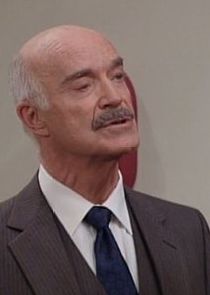
Keene Curtis
Cast appearances.
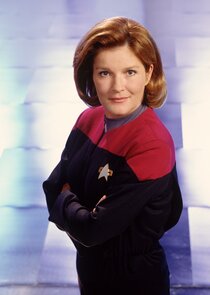
Kate Mulgrew
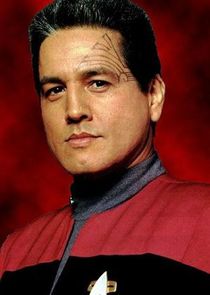
Robert Beltran
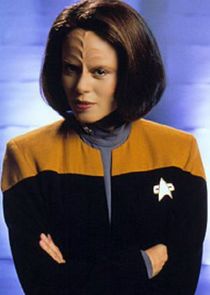
Roxann Dawson

Jennifer Lien
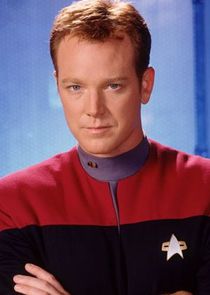
Robert Duncan McNeill

Ethan Phillips
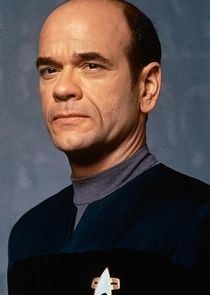
Robert Picardo
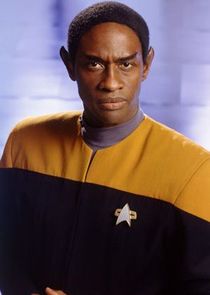
Garrett Wang
Episode discussion.
No comments yet. Be the first!
Star Trek: Voyager/Sacred Ground
Sacred Ground is the seventh episode of the third season of Star Trek: Voyager , and the forty-ninth episode overall.
Guest Starring : Becky Ann Baker (Guide), Harry Groener (Magistrate), Estelle Harris (Old Woman), Keene Curtis (Old Man #1), Parley Baer (Old Man #2)
Co-Starring :
Plot Overview
Janeway undergoes an arduous spiritual test in order to spare Kes from death in a Nechani sacred shrine.
Arc Advancement
Behind the scenes, allusions and references, memorable moments.
- Episode Stubs
- Star Trek: Voyager/Episodes
Navigation menu
Personal tools.
- Create account
- View source
- View history
- Programming grids
- Recent changes
- Random page
- iTunes TV Shows
- Amazon TV Shows on DVD/Blu-ray
- Amazon Instant Video TV
- What links here
- Related changes
- Special pages
- Printable version
- Permanent link
- Page information
sponsored links
- This page was last modified on 25 August 2021, at 17:38.
- This page has been accessed 1,210 times.
- Content is available under Creative Commons Attribution-NonCommercial-ShareAlike 2.5 License .
- Privacy policy
- About The TV IV Wiki
- Disclaimers
- Now Playing
- Airing Today
- Popular People
- Discussions
- Leaderboard
- Cast & Crew
- Translations
- Backdrops 2
- Login to Add a Video
- Content Issues 19

Sacred Ground (1996)
← back to episode, season regulars 9.

Kathryn Janeway

B'Elanna Torres

Guest Stars 5

The Magistrate

Ritual Guide

Marvin V. Rush
Director of Photography

Dennis Madalone
Stunt Coordinator
Robert Duncan McNeill
Daryl Baskin
Geo Athena Trevarthen
You need to be logged in to continue. Click here to login or here to sign up.
Can't find a movie or TV show? Login to create it.

On media pages
On tv season pages, on tv episode pages, on all image pages, on all edit pages, on discussion pages.
Want to rate or add this item to a list?
Not a member?
Sign up and join the community
Star Trek: Voyager
Sacred Ground
Cast & crew.
Becky Ann Baker
Ritual Guide
Estelle Harris
Keene Curtis
Parley Baer
Harry Groener
The Magistrate
Information
© 2009 CBS Corp. All Rights Reserved.
Accessibility
Copyright © 2024 Apple Inc. All rights reserved.
Internet Service Terms Apple TV & Privacy Cookie Policy Support

Star Trek Voyager: Sacred Ground

Love this review. You succeeded in putting down clearly the underlying intricacies that make this episode so special.
We love comments! We moderate because of spam and trolls, but don't let that stop you! It’s never too late to comment on an old show, but please don’t spoil future episodes for newbies.
Star Trek: Voyager (TV Series)
Sacred ground (1996).
- User Reviews
Awards | FAQ | User Ratings | External Reviews | Metacritic Reviews
- User Ratings
- External Reviews
- Metacritic Reviews
- Full Cast and Crew
- Release Dates
- Official Sites
- Company Credits
- Filming & Production
- Technical Specs
- Plot Summary
- Plot Keywords
- Parents Guide
Did You Know?
- Crazy Credits
- Alternate Versions
- Connections
- Soundtracks
Photo & Video
- Photo Gallery
- Trailers and Videos
Related Items
- External Sites
Related lists from IMDb users

Recently Viewed
- Buy the Book…
- Reviews Hub

the m0vie blog

Following Us
- Adding Our RSS Feed to Your Gmail
- Following our Feed in Internet Explorer
- Millennium (Reviews)
- Star Trek: Deep Space Nine (Reviews)
- Star Trek: Enterprise (Reviews)
- Star Trek: The Next Generation (Reviews)
- Star Trek: The Original Series (Reviews)
- Star Trek: Voyager (Reviews)
- The X-Files (Reviews)
- X-Files Fandom Poll Form
Check out the Archives

Awards & Nominations

Star Trek: Voyager – Sacred Ground (Review)
This February and March (and a little bit of April), we’re taking a look at the 1995 to 1996 season of Star Trek , including Star Trek: Deep Space Nine and Star Trek: Voyager . Check back daily for the latest review.
Sacred Ground is a rather strange episode.
In a way, this is where the second season of Star Trek: Voyager dies. This is certainly true in a literal sense; it is the last of the four episodes held over from the end of the second season, buried between a quarter and a third of the way into the show’s third year. However, the episode also closes out some of themes that were bubbling through the first two years of the show. Michael Piller had imbued the first two seasons of the show with a new age spirituality, mostly through the character of Chakotay. Sacred Ground closes that out.

There is a sense that the show is uncomfortable with Sacred Ground . Although it was the first of those four carryover episodes to be produced, Sacred Ground was the last of the four to be broadcast. While the decision to air Basics, Part II at the start of the season makes logical sense, it is strange that the production team would choose to bury the episode as far into the season as possible. Of those four episodes, the production team were ready to air False Profits before Sacred Ground . That is a frightening thought.
It is understandable. Voyager ‘s previous attempts at new age mysticism had not gone well, reducing Chakotay to a Native American cliché in episodes like The Cloud and Tattoo . However, it is also quite frustrating, as Sacred Ground comes closer to working than any of Piller’s earlier attempts.

Burying the consequences.
Of course, Sacred Ground comes with all the stock flaws that one expects from Voyager at this point in its run. There are quite a few pacing issues with Sacred Ground , most of which are tied to the show’s reluctance to embrace a truly “off-model” episode. Much like Resolutions or The Swarm , there is a sense that Sacred Ground is deeply uncomfortable with a quiet character-driven episode, and so rushes to substitute in stock Voyager plot elements. These ultimately slow the pacing down and really undercut the episode’s strongest elements.
Sacred Ground is very much written as a showcase episode for Kathryn Janeway. Although it was written and produced at the tale end of the Michael Piller era, it is very firmly rooted in Jeri Taylor’s vision of the character; Sacred Ground is a story about Janeway both as a mother to her crew and as a woman of science. On top of that, the episode is very much a showcase for actor Kate Mulgrew, who is the only member of the primary cast on-screen for entire extended sequences as she completes her journey of spiritual awakening.

Stone’s throw away…
Mulgrew is very good. Although not always well-served by the material she was given, Mulgrew does her best to make Janeway a compelling and intriguing character. In fact, fellow cast member Robert Duncan McNeil was elated to discover that his directorial debut would be a Janeway-centric episode :
“No, it made me less nervous, because I have a good relationship with Kate,” he said. “Kate’s trailer and my trailer are sort of separated from the rest of the cast, just because of the way they’re set up on the lot. I probably talk to Kate most often, because we’re stuck there together. I know what a hard worker she is, and I was thrilled that she had the story for my first episode. We have such a great relationship. We were able to discuss the scenes in more depth than the average directors might.” Mulgrew said that McNeill has a “velvet touch” as a director.
Mulgrew effectively anchors the episode, in much the same way that Patrick Stewart grounded Picard-centric episodes like Darmok , The Inner Light and Tapestry . Of course, Mulgrew isn’t quite as good as Stewart, who remains one of the franchise’s best performers, but she is still compelling to watch.

“We are far from the sacred places of our grandfathers and from the bones of our people.”
The biggest issue with Sacred Ground is the episode’s reluctance to let Mulgrew carry the episode on her own terms. The sequences of Janeway undergoing her spiritual awakening are long and weird, utterly unlike anything the viewers have come to expect from Voyager . There is a minimal amount of tension and very little immediate threat, all giving way to abstract imagery and colourful metaphor. It does not always make sense, occasionally falling back on new age clichés and trite sentiments, but it is interesting and unique.
This strangeness appears to have unsettled the production team in the same way that the EMH-centric plot of The Swarm or the “J and C” elements of Resolutions did, so Sacred Ground keeps cutting away from these quiet planet-based scenes to needless filler back on Voyager. Sacred Ground cannot seem to work a thrilling deep space battle into the subplot, so Sacred Ground keeps cutting away from the scenes on the planet to sequences of the EMH and Neelix bickering over the best course of action and what to do next.
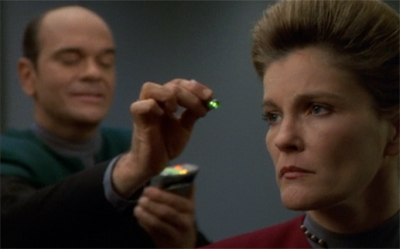
Techno! Techno! Techno!
Of course, these scenes don’t really do that much. They don’t drive the plot or contribute to the audience’s understanding of the episode’s themes. They are pure filler, designed to make use of the Voyager sets and pad the episode out to the forty-five minute runtime. As a result, the sequences are filled with nonsense techno-babble. At one stage, the EMH speculates, “Neuropeptide levels this high could well create a natural barrier to biogenic energy.” That is a massive (and nonsensical) over-elaboration on the point.
These sequences are clearly intended to build suspense, to reassure viewers that there are active and material stakes to what is going on. Chakotay shows up to offer a number of possible hypothetical scenarios wherein Janeway might be in danger, as if the show is worried that viewers have no interest in watching an episode where Janeway’s life isn’t under immediate threat. There are also repeated assurances that Kes is still in a coma, just in case viewers have forgotten the event that spurred the whole plot into motion at the end of the teaser.

Picture this…
In many respects, Sacred Ground is a reminder that Voyager will never be in a situation where it could produce an off-format episode like Tapestry , The Inner Light , Explorers , or The Visitor . While the show touches on some of those ideas and themes in later episodes, they are always undercut by the demand for scale and spectacle. Timeless is perhaps the best example, a meditation on guilt and regret that still features a mandatory action sequence. Lifeline is another example, the story of a father and son that requires two stunt guest stars to carry it.
Whether at the behest of the network or the production team, this refusal to just embrace a quieter and more introspective story style is a limitation that will hurt the show in the medium-to-long-term. More immediately, it completely kills the mood and pacing of the episode, while suggesting that Voyager itself has little interest in the story being told. It is hard to invest too heavily in Sacred Ground when the very structure of the episode seems to suggest that Janeway’s spiritual quest cannot carry an episode by itself.

“They should really put up better warning signs. I thought the toilet was back here.”
There are other problems with Sacred Ground that are tied to the way that Voyager has decided that it wants to tell stories. As with the ending to The Swarm , there is a sense that the closing scenes of Sacred Ground are aiming for a profundity that it never quite earns. In The Swarm , it is suggested that EMH’s memory has been wiped and that he only has the faintest (subconscious) recollection of his character development from the show’s first two seasons. However, the character is back to his usual self in the very next episode.
Sacred Ground has the same essential problem. At its core, Sacred Ground is essentially an episode about confronting a rational and scientific person like Kathryn Janeway with a profoundly spiritual experience, and watching how that experience affects her world view. The closing scenes of Sacred Ground suggest that these experiences have had a profound impact. When the EMH offers a bases-covering techno-babble explanation for what happened, Janeway half-heartedly responds, “It’s a perfectly sound explanation, Doctor. Very scientific.”

Making quite a mark…
If Kirk is an explorer, if Picard is a diplomat, if Sisko is a builder, if Archer is a pilot, then Janeway is a scientist. Although Voyager never quite gets a steady read on Janeway as a character, the show has hit on this pointed repeatedly in episodes like Heroes and Demons and Cathexis . Indeed, one reading of the character might suggest that Janeway’s difficulties with the burdens of command are rooted in the simple fact that she came up through the science division. At times, it seems like Janeway is even more of a scientist than a captain.
So undercutting that should fundamentally change the character. It should alter the way that the character views the universe and complicate the way that the audience sees the character. The universe is not as black and white as it once seemed; Janeway has undergone a profound experience and been left changed by it. Sacred Ground feels like it should fundamentally change the character, like The Best of Both Worlds, Part I changed Picard or like Accession changed Sisko. It does not have to be a big showy reversal, but it has to be something.

Does not scan.
On Star Trek: The Next Generation , most of the character changes seemed to be subtle; the evolution of characters like Riker, Geordi and Troi seemed as rooted in the actors playing the roles as the writers who wrote the scripts. Nevertheless, it seemed like every member of the cast had changed significantly between Encounter at Farpoint and All Good Things… Meanwhile, Star Trek: Deep Space Nine made a point to give its characters fully-formed arcs, changing them dramatically from season to season.
In contrast, Voyager affords its leads very little room to grow or evolve. Janeway’s personality shifts dramatically from episode to episode, but it is too inconsistent and erratic to be truly considered “growth.” Chakotay, Tuvok and Harry seem unchanged between Caretaker and Endgame . In fact, the closest thing that Chakotay experiences to growth is the writers’ decision to shift emphasis away from his new age mysticism following the departure of Michael Piller at the end of the second season.
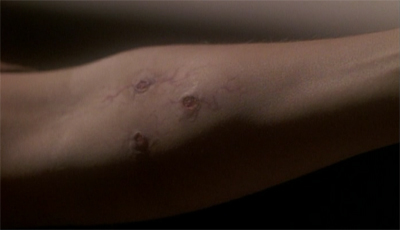
A biting criticism…
The closing lines of Sacred Ground suggest that the episode should have some lingering impact, but that is not possible within the framework of Voyager as it exists at this moment in time. In a way, Sacred Ground could be seen to stand between the two eras of the show, offering a closure to the mystical new age themes of the Piller era with the half-hearted shrug of the Taylor era. It is an ending to this particular story, but the audience can rest assured that everything will be back to its factory default settings by the start of Future’s End, Part I .
It is a shame, because these elements undercut what is otherwise an endearingly weird little episode. Sacred Ground feels like it fits more comfortably in the ambiguous cosmology of Deep Space Nine rather than the techno-babble driven pulp sci-fi of Voyager , populated by characters who may or may not be deities and driven by events that may or may not be supernatural. The religious archeology of Sacred Ground even prefigures similar touches in Rapture and The Reckoning , while the nose-ridge makeup on the Nechani evokes the Bajorans.

Janeway lightens up…
Interviewed by Cinefantastique , Lisa Klink confessed that the episode posed an interesting challenge as compared to other Voyager episodes:
“It was tricky, because obviously it was very talky, and philosophical, and you really had to pay attention to keep up with what was going on. That was one of the harder scripts that I’ve ever written. The point of the episode is that you can’t explain everything. That’s really what faith is about. She is someone who has great faith in the ability of science to explain everything. This is kind of a reminder to her that there’s a lot of really weird stuff out there in the universe. It’s just a question of keeping an open mind and allowing herself to just accept some things without being able to actually pin it down, and scan it, and measure it, and explain it all in a nice little burst of technobabble.”
It is not a bad idea, even if it does feel like a microcosm of Sisko’s arc on Deep Space Nine .

Carrying on.
Klink’s writing has a lot to recommend it. In particular, Sacred Ground offers a very nuanced depiction of religious faith. It avoids the clichés of hard line zealotry and absolutism that frequently accompany portrayals of devout belief. Perhaps the harshest criticism of Nechani would be that they should probably signpost their religious sites better, or at least put up a cordon to block tourist access to the deadly gateway. Broadly speaking, Sacred Ground is sympathetic towards Nechani belief, even their stubborn refusal to allow detailed scans of the site following Kes’ accident.
Many of the guest characters play as subversions of Star Trek archetypes, most notably Harry Groener as the Magistrate. Alien authority figures in stories like this tend to come in two varieties, both hostile; the open hostility demonstrated by Ambassador Liria in The Chute or the duplicitous behaviour of Jor Brel in Remember . Given that Sacred Ground requires Janeway to face resistance from the Nechani, it makes sense to cast the Magistrate as an antagonistic force; the fact he doesn’t even have a name in the opening credits all but screams “obstructive bureaucrat.”

“I mean, think of what would happen to the Nechani tourist industry if she dies. Well, actually, we’d still be one of the top ten places to visit in the Delta Quadrant according to Lonely Galaxy.”
Instead, the Magistrate is shown to be considerate and compassionate. He actively encourages Janeway to do whatever she can, and seem genuinely emotionally invested in saving Kes’ life. “If I could help you, I would,” he explains to Janeway. “I swear it. I blame myself. If I’d watched more carefully, seen that she was approaching the shrine.” He seems genuinely happy at Janeway’s plan to help Kes. “I have been greatly troubled by your misfortune, Captain. If you are able to convince the spirits to spare your friend, no one would be happier than I.”
Sacred Ground takes a lot of care and effort to make sure that the Nechani are more than just stock religious zealots. As far as Delta Quadrant aliens go, they are friendly and open; even allowing for the fact that Kes almost dies visiting their planet, they are still more welcoming than the vast majority of aliens to appear on Voyager . There is no attempt to murder or manipulate the crew, no attempt to cover up genocide. The Nechani appear to be a genuinely pleasant people, when it would have been easy to make them cardboard antagonists.

An illuminating conversation.
Even their religious leaders respond to Janeway’s desire to investigate their customs with curiosity. “Your creative approach to this problem has fascinated the Nechisti Council,” the Magistrate observes. “They consider it an honour that you want to seek the spirits.” There is not subterfuge or misdirection happening here. The Nechani are well aware of the microprobe under Janeway’s skin, but do not treat it as a violation of the ritual. (Although this does make it strange they won’t simply allow detailed scans of the caves.)
The rituals themselves are very new age, to the point that the Nechani put Janeway in what amounts to a sensory deprivation tank so that she might commune with the Ancestral Spirits. The vision is very mystical and natural, with Janeway imagining herself standing on a beach. It feels like a logical continuation of the new age imagery that Michael Piller baked into The Cloud and Tattoo , albeit without the awkward appropriation of Native American spirituality. In fact, it comes quite close to the early portrayal of the Bajoran religion on Deep Space Nine .

“You know, Captain Ransom recommended this spot.”
It makes sense that Star Trek should be permeated with new age themes and imagery. As with a lot of the themes and ideas bubbling through Voyager , this fascination with new age spirituality reflected the show’s geographical home; much like the Kazon were intended as a commentary on Los Angeles gang culture and The Chute touched on California’s overcrowded and hyperviolent prison system, these new age themes reflected the mood and spirituality of California in the middle of the last decade of the twentieth century.
California’s religious and spiritual beliefs have always been interesting. Standing at the very edge of the Pacific Ocean, California represents the end of westward expansion and the logical conclusion of Manifest Destiny. California sees the desert giving way to the ocean, and is the very edge of American. From a viewpoint of the settlement of America, it is very much “the final frontier.” Perhaps that is why the region has always had such an eclectic spiritual history , from the Summer of Love to the Manson family to Heaven’s Gate to new age belief.

“Cult figures.”
Al Ridenour has suggested that this spirituality is very much part of the fabric of the state, tied up in its history :
Historically, ever since the railroads connected the West Coast to the East, it was always the land of opportunity and utopia. A big part of it was the weather and the escapism that weather represented. It’s a natural place where oranges grew—a sort of Eden, basically. It was like that and then with entertainment and Hollywood, that fueled the whole escapist mentality. Everything worked together to make California and Southern California a haven for cults and movements like that.
It should be noted that Star Trek was far from the nineties only genre show tied up in new age themes; look at The X-Files , for example.

Stripped of command.
If Star Trek is to engage with a spirituality, it makes sense for the franchise to embrace new age philosophy. Although results may vary in practice, new age spirituality is often a liberal and open-minded attempt to integrate utopian ideals into a pseudo-scientific framework with healthy helping of multicultural mysticism. As Douglas Groothuis argues in Unmasking the New Age :
Western optimism and belief in progress pervade the new spirituality—something often foreign to classical Eastern religions. The theory of evolution is invested with mystical potency, as we saw in chapter one. Noted New Age scholar Ken Wilber confesses: “I really trust evolution. I really don’t think God would screw us around that bad.” Our present crisis is seen as generating incredible opportunity. The New Age spirituality is also bolstered by avant-garde theories on “the frontiers of science.” Western respect for science has influenced many people to take seriously the claims that quantum physics, holographic theory or other scientific ideas should push us into the One’s lap. New Age spirituality is not an island of personal mystical experience isolated from scientific concerns; it often looks to science for inspiration and confirmation, as is evidenced by the popularity of Capra’s The Tao of Physics.
Of course, the reality of new age spirituality is a lot more complex. The belief system opens itself up to accusations of cultural appropriation , as ably demonstrated by the way that Chakotay’s spirituality is portrayed. It also something of a generalisation to suggest that “new age” movement embraces progress, given the overlap that exists between “new age” practitioners and the anti-vaccination movement .

Janeway’s a little stoned right now.
As such, the “new age” movement is deeply problematic and complicated, a mess of contradictions and irrationality. However, in its purest and most idealistic form, it is a surprisingly comfortable fit with the philosophy of Star Trek . Unfortunately, as episodes like Tattoo have demonstrated, the more ill-judged elements of new age philosophy are also a comfortable fit with the franchise. After all, Star Trek has issues with its racial politics even beyond its handling of new age mysticism.
Still, Sacred Ground offers Voyager ‘s most idealistic interpretation of new age philosophy – suggesting a future where religious faith and scientific reason are not at odds with one another. It seems that Sacred Ground accomplishes a lot of what Michael Piller was trying to do with the character of Chakotay, albeit divorced from the context of cultural appropriation surrounding the first officer. As such, it feels almost appropriate that this should be the end point for that particular story (and thematic) thread seeded through the Piller era.

The writing’s on the wall…
However, Sacred Ground also represents a beginning of sorts. It marks the first episode of Star Trek to be directed by Robert Duncan McNeill. In fact, it is McNeill’s first directorial credit at all. Although he had been acting since the early eighties, McNeill had long wanted to be a director :
I’d done a show called Going to Extremes, which was in 1992. We filmed it in Jamaica. I had a lot of time on my hands, being out of the country, away from home. That’s where I started observing directors. I’d always thought about it, but didn’t know what they did exactly and what the process was. So I used the opportunity to observe and learn. That’s when I knew directing was what I wanted to do. Star Trek was the opportunity. I told Rick Berman, on the first day of the pilot, when we walked away from the stage, that I was happy to be on the show, but that if it ran for even only a few years I wanted to start directing, that that was my long-term ambition.
Much like Jonathan Frakes, McNeill would use his experience behind the scenes on Star Trek to transition from an industry role in front of the cameo to a career behind the camera. McNeill has directed for shows as diverse as V , The O.C. and Dead Like Me . He also served as a producer on Chuck .

“Do you guys know the Prophets? Because it seems like you’d get on.”
The comparison to Jonathan Frakes seems entire appropriate. After all, McNeill only landed the job of directing Sacred Ground after Frakes pulled out at the last minute to handle directorial duties on Star Trek: First Contact . As McNeill reflected to Cinefantastique :
“It’s kind of ironic, because what happened was Jonathan was scheduled to direct an episode of the show and when he was offered the feature he had to step out and couldn’t direct an episode for us. When I heard that I thought about it long and hard and went to Rick with my list and said ‘Here is what I’ve done and I think I’m ready. I don’t have any expectations, but I want to get on the list of people to take that spot.’ That was the only [episode] available, everything else was booked up. We had a good conversation and I walked away feeling that he did believe that I was ready, but I didn’t really expect to get the episode. I was pushing that one thinking I would get one early next season. About a week or two later he called me in Cincinnati — I was at a convention — to say that they had a meeting about it and wanted to give me the shot. So thanks to Jonathan Frakes I will become the next Jonathan Frakes.”
McNeill does a solid job with the material, although Sacred Ground is a challenging script for a first time director. McNeill makes a conscious decision to ground all the weirdness in Kate Mulgrew’s performance, opting for a straightforward approach to the more supernatural elements. It works well enough.

Neelix is the worst museum tourist.
Sacred Ground is a strange little episode undercut but its refusal to commit to either the strangeness itself or the consequences of that strangeness. In a way, it marks the perfect intersection between the second and third seasons of Voyager .
You might be interested in our other reviews from the third season of Star Trek: Voyager :
- Basics, Part II
- False Profits
- Sacred Ground
- Future’s End, Part I
- Future’s End, Part II
- The Q and the Grey
- Blood Fever
- Favourite Son
- Before and After
- Distant Origin
- Worst Case Scenario
- Scorpion, Part I
Share this:
Filed under: Voyager | Tagged: lisa kling , new age , religion , robert duncan mcneill , sacred ground , spirituality , star trek: voyager , voyager |
7 Responses
I have said it before, but this is my least favorite episode of star trek. I have to confess to a hatred of new age mumbo jumbo, but the message is also just severely botched. The episode seems to argue that science is like religion, and that people believe in it blindly. That is not science, as science is rational intellectual thought. The episode is also just incredibly dull because the viewer can see the final act, Janeway choosing to believe and embracing mystic nonsense, a mile away. Finally, the whole premise of this episode is incredibly contrived. Why on earth did the aliens not warn Voyage of the sacred arch before bringing them down there? It would be like taking an uneducated person to Jerusalem, and not explain the wailing wall.
“Why on earth did the aliens not warn Voyage of the sacred arch”
It’s a sci fi trope. Aliens never, ever explain anything until it is too late. (What if God was one of us? Just a clod like one of us?) The same can be asked of 99.8 percent of TOS. As for Star Trek, it’s more interested in pushing the ‘message’ than it is in internal logic. In the case of “Memorial”, it works, but that’s sort of incidental.
“a hatred of new age mumbo jumbo”
How are we supposed to take any of it seriously? The Doctor’s technobabble is worse than anything coming out of Chakotay and Kira’s mouths.
The Captain’s scientific background rarely came into play, anyway. The episode hinges on a show bible which has already been overwritten. The episode was fruitless in that regard. Bad times. And how annoying that TNG, DS9, VOY, and ENT farted around for three years trying to find their voice.
That aside, I do think there is a place for spirituality. It worked pretty well in X-Files and BSG, even if the writing staff succumbed to the dark side (meaningless visions designed to throw viewers off the track a la LOST).
I don’t mind it so much. It’s certainly better new age nonsense than most of the Chakotay stuff. And I don’t mind the idea of science and religion coexisting. I think the idea that they are mutually exclusive is a large part of the culture war. (For the record, I am a lapsed Catholic. It’s the real Irish state religion.)
I always got the impression that Sacred Ground was originally intended as a DS9 episode (even guest star Becky Ann Baker is a dead ringer for Kai Winn) with Sisko in place of Janeway on a spiritual quest to seek the Prophets to cure Jake instead of Kes with Kira as his guide to convince him he’s the Emissary. DS9’s S5 equivalent (another case of these seasons melding together) was undoubtedly Rapture with Sisko taking a similar leap of faith to Janeway’s.
Some of Sacred Ground’s pacing issues may be due to Robert Duncan McNeill’s inexperience as a director. Original choice Jonathan Frakes would no doubt have given the episode more in the way of snap but I feel that would have been inappropriate to the episode’s tone. Sacred Ground is a more thoughtful meditation on religious themes than the more recent likes of False Profits and all the better for it.
Was this always intended as a Janeway episode? If this had been a product of the Michael Piller era, Chakotay might have been seeking the Sky Spirits (instead of the Nechani’s Ancestral Spirits) to strengthen the beliefs that he lacked in his youth, except it sounds too similar to Tattoo, and that was a well Voyager would thankfully never revisit again.
Ha, I hadn’t quite pegged the connection to Rapture, most likely because I reviewed the Sacred Ground as part of the S2 production block, but you’re entirely correct. S3 of VOY and S5 of DS9 really do line up surprisingly well with one another.
And it’s something I’ve only just noticed while reviewing these seasons. There are more examples to come but I’ll cover those when we come to them.
“McNeill has directed for shows as diverse as V, The O.C. and Dead Like Me.” How diverse can they be, they all rhyme! (And so my periodic contribution to the comments section is complete. Terribly sorry.)
Leave a comment Cancel reply
This site uses Akismet to reduce spam. Learn how your comment data is processed .
Recent Posts
- 373. Pirates of the Caribbean: The Curse of the Black Pearl (#225)
- 371. Poor Things (#246)
- 370. Dune: Part Two (#12)
- 369. Memento (#57)
- 368. Monty Python and the Holy Grail (#154)
Recently tweeted…
- "I Simply Am Not There": The Existential Horror of Eighties Excess in "American Psycho"...
- Star Trek: The Original Series (Reviews)
- Star Trek: Voyager (Reviews)
- The Ambiguous Ending of The Usual Suspects...
Available at…

Blogs Well Worth Your Time
- 1001 Must See Films
- Andrew at the Movies
- Anomalous Material
- Cut the Crap Movie Reviews
- Encore Entertainment
- Fandango Groovers
- FlixChatter
- Four of Them
- It Rains… You get Wet…
- Jameson Cult Film Blog
- Jar Watches Films
- Let's Go To The Movies
- M. Carter at the Movies
- Marshall and the Movies
- Movie News First
- Musings from a Man Lost in La Mancha
- Never Mind Pop Film
- Paragraph Film Reviews
- Roger Ebert's Journal
- Ross v. Ross
- Scannain.com
- Screenwriter (Donald Clarke, Irish Times)
- Strange Culture
- The Film Cynics
- The Pompous Film Snob
- The Projection Booth
- Things That Don't Suck
- Too Busy Thinking About My Comics
- Undy a Hundy
Film Nerd Resources
- CinemaBlend (News)
- Internet Movie Database
- Rope of Silicon
- The Guardian Film Blog
- James Berardinelli
- Roger Ebert
Email Subscription
Enter your email address to follow this blog and receive notifications of new posts by email.
Email Address:
Sign me up!
Blog at WordPress.com. WP Designer.
- Already have a WordPress.com account? Log in now.
- Subscribe Subscribed
- Copy shortlink
- Report this content
- View post in Reader
- Manage subscriptions
- Collapse this bar
Sacred Ground
Kes is injured when she accidentally commits sacrilege on an alien planet; in order to save her life, Janeway must go through a mysterious ritual that challenges her faith in science.
In this episode of the podcast, Wes and Clay discuss “Sacred Ground” and getting deep into new-age mysticism. Plus! The guys chat about keeping tabs on your medical condition, misunderstanding science, and voicing Mrs Potato Head.
- Post author By Wes
- Post date 02/21/2023
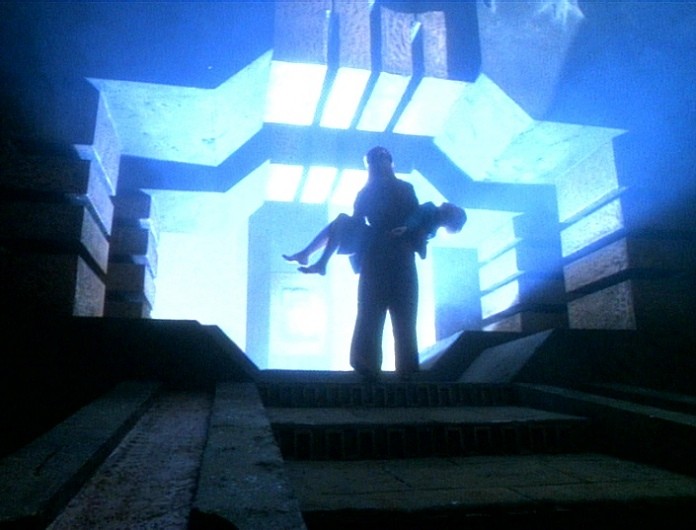
Subscribe: Apple Podcasts | Spotify | RSS | More
Star Trek: Voyager has dabbled in Michael Piller’s interest in new-age mysticism previously, but “Sacred Ground” grabs the idea by the horns and wrestles it to the altar. “Sacred Ground” is the last holdover from the second season and shares a lot of qualities with that infamous season. But it’s also a Janeway vehicle that attempts to challenge the good captains world view.
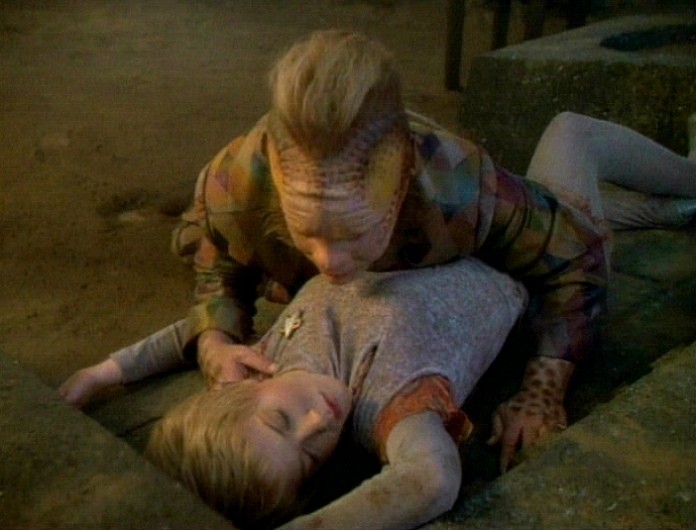
The Wikipedia plot summary for “Sacred Ground”:
he crew take shore leave on a friendly planet inhabited by people called Nechani. A group become interested in the Nechani’s religious sites and take a tour. Kes is put into a coma when, out of curiosity, she touches a natural biogenic field. The Doctor cannot help, in part because the monks will not allow readings to be taken around the field. Neelix investigates and returns with a story of a King and his son. The son was seemingly injured as Kes was and the King went through an initiation in order to awaken him.
Janeway petitions the monks to allow her to perform the same ritual. The Doctor places a probe in her bloodstream, determined to find out the science behind the rituals. Janeway expects the course to consist of tests of physical endurance, mental discipline, and perhaps psychoactive drugs which would change her body chemistry, allowing her to pass through the field.
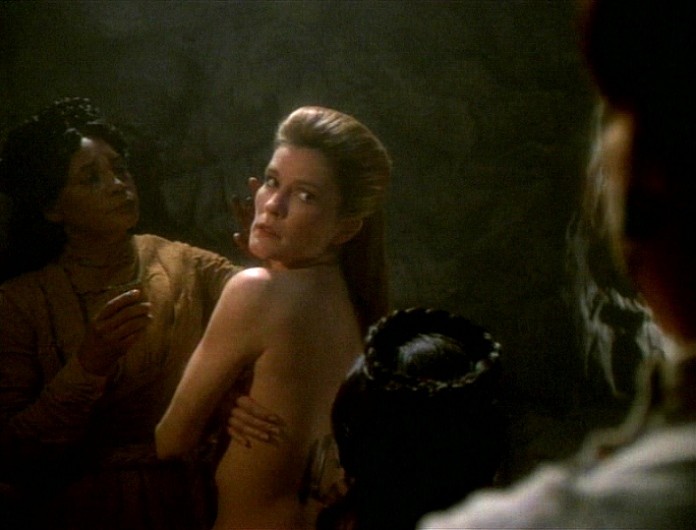
Janeway goes through the first series of tests; her guide warns that they are meaningless, the point is for Janeway to get in touch with the spirits. She ends up bitten by a creature which is supposed to allow her to contact the spirit world. Her guide seems to say that the spirits find Janeway’s inquiries about Kes’ plight inconsequential because she already knows how to fix Kes.
The Doctor thinks the venom from the creature might be the cure needed for Kes. It is not. Janeway convinces her command crew to let her go to the ritual site again, convinced that if she takes Kes through the field, it will work. Her guide allows it, indicating that Janeway’s desire to go through is all that is needed. Kes is healed of her affliction. The Doctor comes up with a scientific explanation for how Kes was healed. Janeway seemingly expresses doubt that it was science.
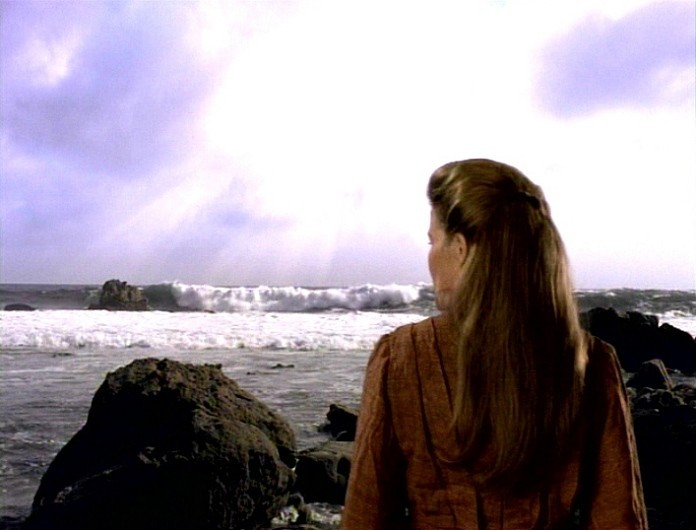
Sacred Ground Stardate: 50063.2 Original Airdate: October 30 1996
<Back to the episode listing
Star Trek ® is copyright of CBS Studios Inc . Copyright © 1966, Present. The Star Trek web pages on this site are for educational and entertainment purposes only. All other copyrights property of their respective holders.
- Bahasa Indonesia
- Slovenščina
- Science & Tech
- Russian Kitchen
Further inside the mysteries of St. Basil's
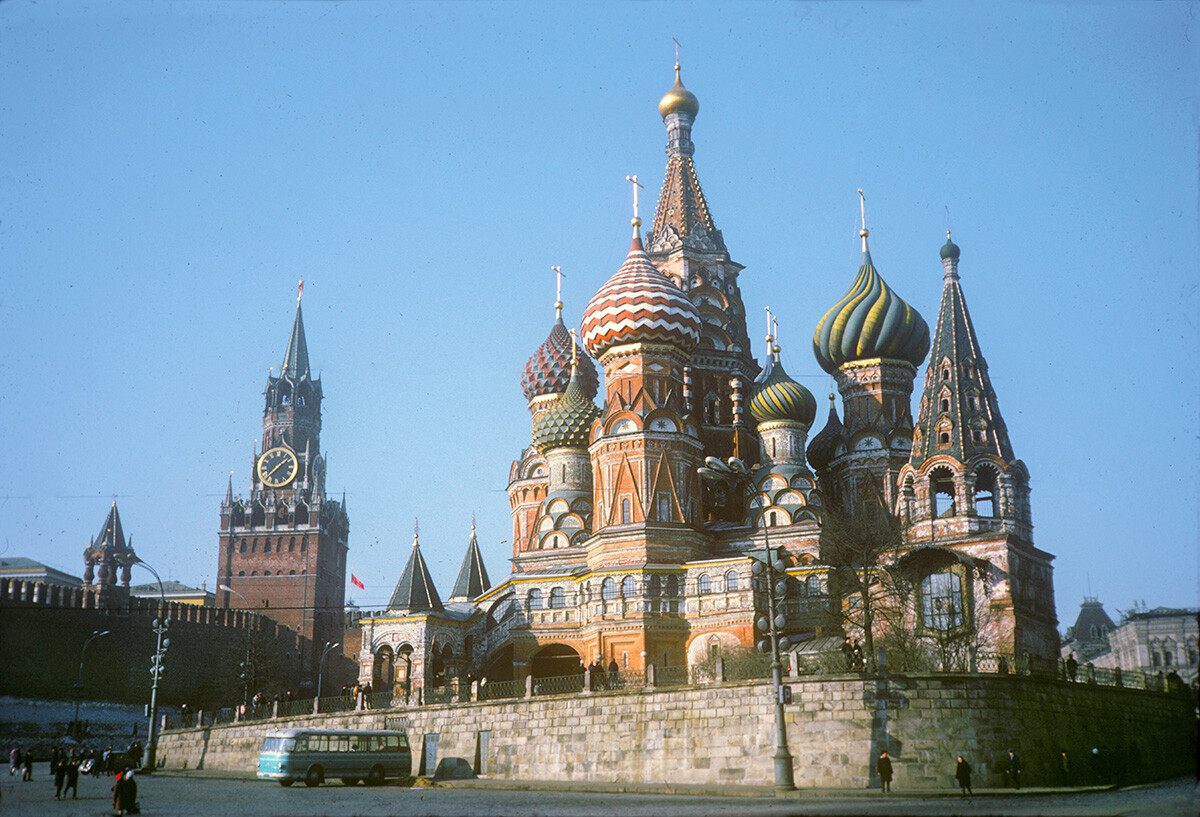
Moscow. Cathedral of the Intercession on the Moat (St. Basil's). South view. February 20, 1972.
Although Russian chemist and photographer Sergey Prokudin-Gorsky is best known for his photographs of the Russian Empire in the early 20th century, he also established a business that produced color postcards and illustrations in books. Among the publications with his color photographs was a large volume published in 1913 on the occasion of the tercentenary of the Romanov dynasty. The illustrations included his reproduction of a tinted watercolor made for an album presented in 1673 to Tsar Alexei Mikhailovich in commemoration of the enthronement of his father, Mikhail Fedorovich, the first Romanov tsar.
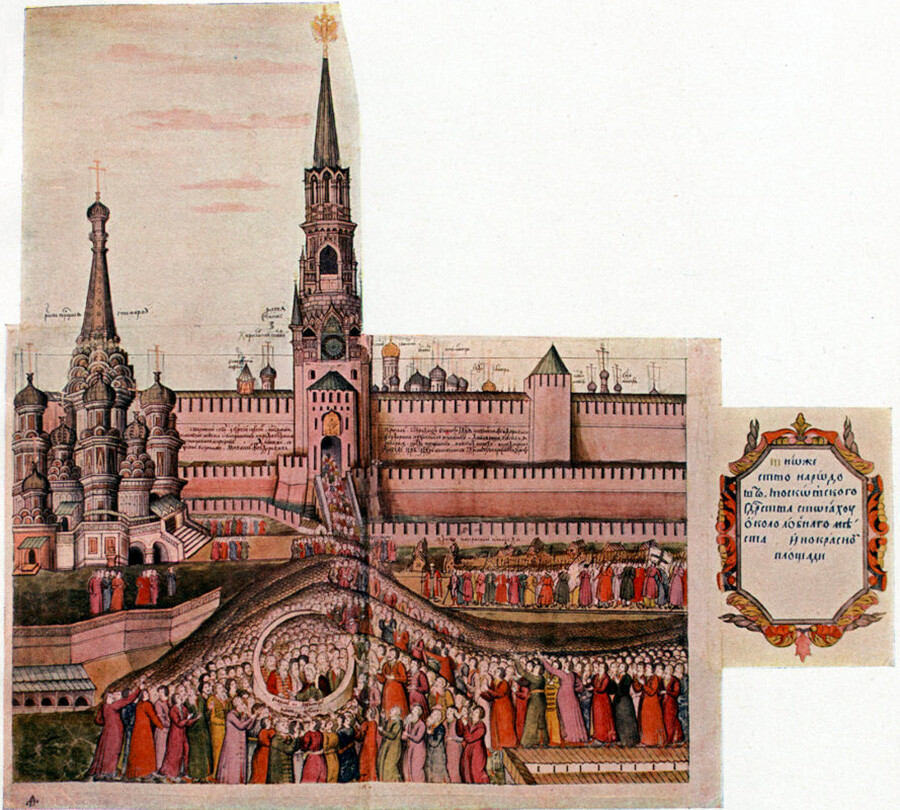
Red Square. Proclamation of Enthronement of Tsar Michael Romanov. From left: St. Basil's, Lobnoye Mesto, Kremlin wall & Savior (Spassky) Tower. Reproduction of 1673 tinted engraving published in P. G. Vasenko, Romanov Boyars and the Enthronement of Mikhail Fedorovich (St. Petersburg, 1913).
The watercolor purports to show the solemn occasion on February 21, 1613 when the people swore fealty to the newly chosen Tsar Mikhail on Red Square. The main architectural feature of the watercolor is the multi-domed St. Basil's Cathedral. Despite its fame, the complex structure continues to pose riddles. Even its name varies: from the popularly accepted “St. Basil’s” to its formal designation as the Cathedral of the Intercession on the Moat. In the 17th century it was also referred to as “Jerusalem.”
Having photographed this consummate landmark for decades, I was able in 2012 to re-photograph the interior with a digital camera.
Monument to Muscovy and Orthodoxy
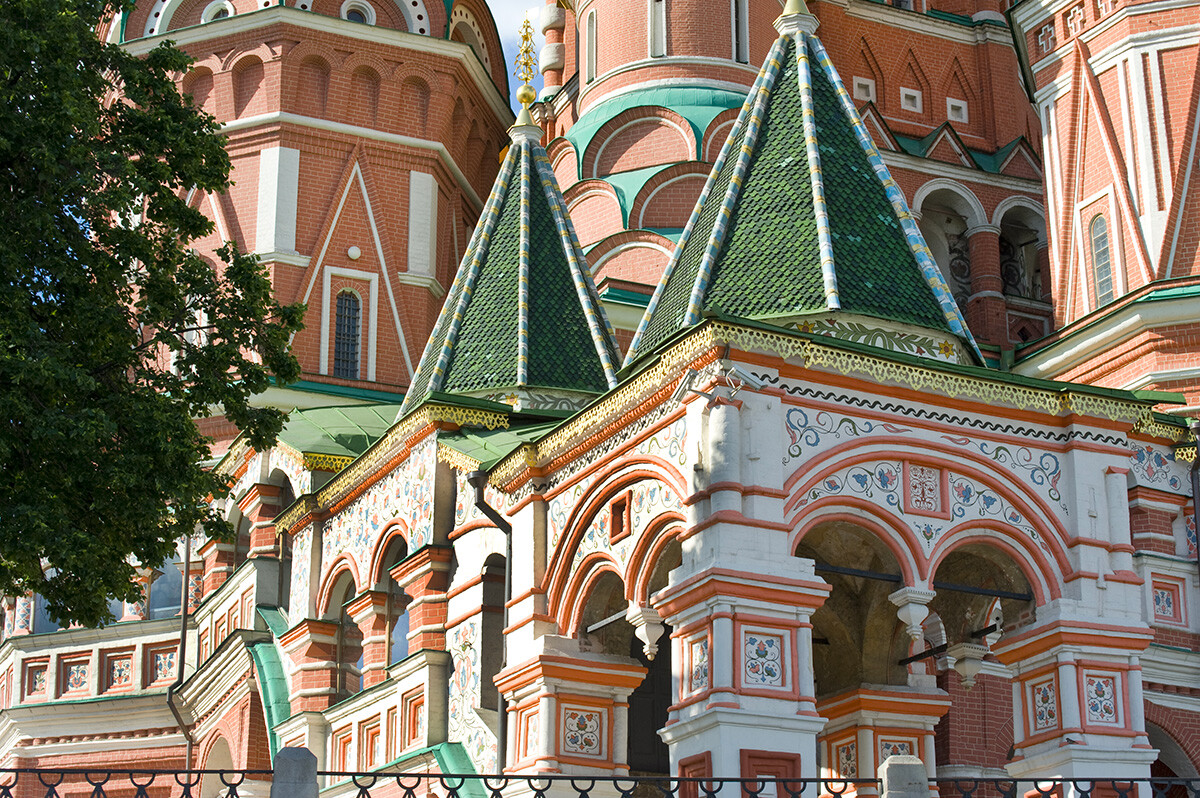
St. Basil's. Southwest entry stairway. May 26, 2012.
St. Basil's is located on high ground above the left bank of the Moscow River and provides a visual landmark over a large space known since the middle of the 17th century as Red (or "beautiful") Square. The church accordingly served as a symbolic link between the Kremlin, the center of political power, and the posad, the densely settled mercantile area in Kitay-Gorod. The origins of St. Basil’s are as complex as its form. Soon after Tsar Ivan IV (the Terrible) captured the city of Kazan on October 1-2, 1552, he commanded that a church dedicated to the Holy Trinity be erected on the square outside the Kremlin at the Frolov Gate.
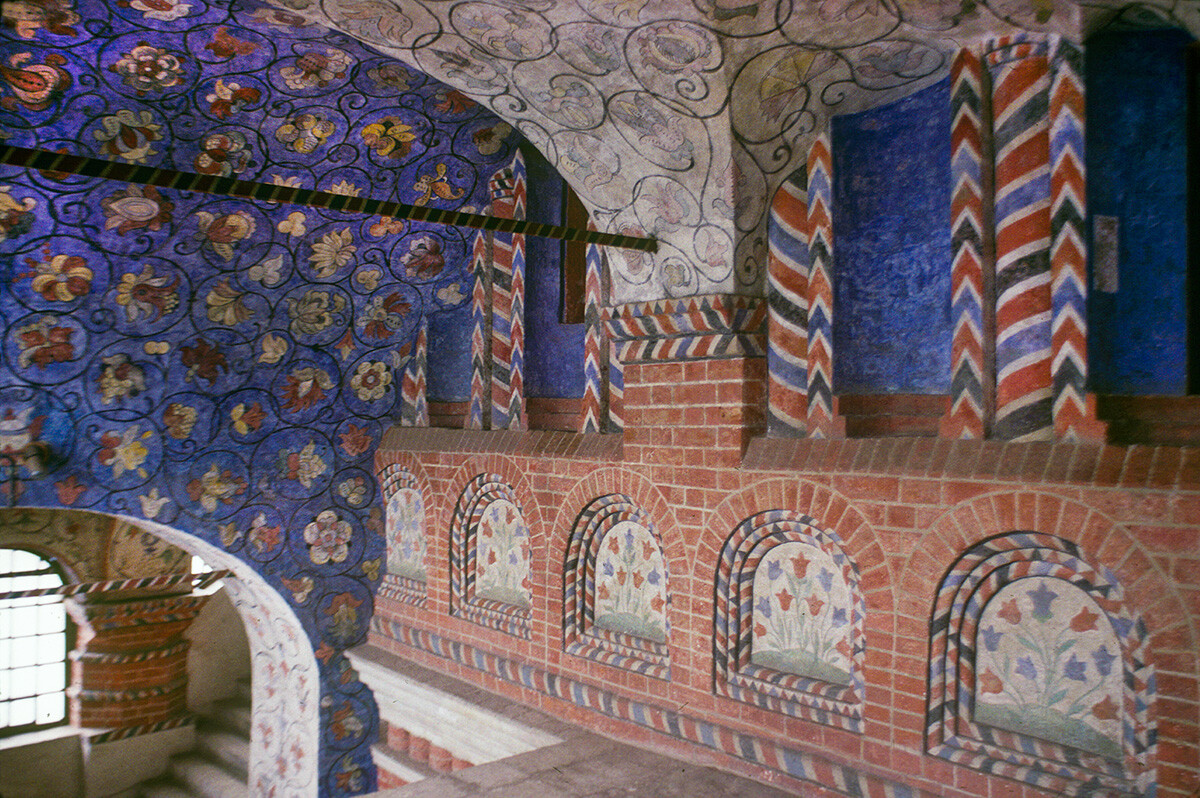
St. Basil's, interior. Southwest entry stairway. June 21, 1994.
Ivan intended to rebuild that church on a scale reflecting the importance of his defeat of Kazan, which not only eliminated a troublesome relic of Mongol power, but also opened a vast area for colonization and trade. Although the temple might seem a chaotic agglomeration of parts, its architects – generally recognized as Ivan Barma and Postnik Yakovlev – created a logical plan with a wealth of layered meaning.
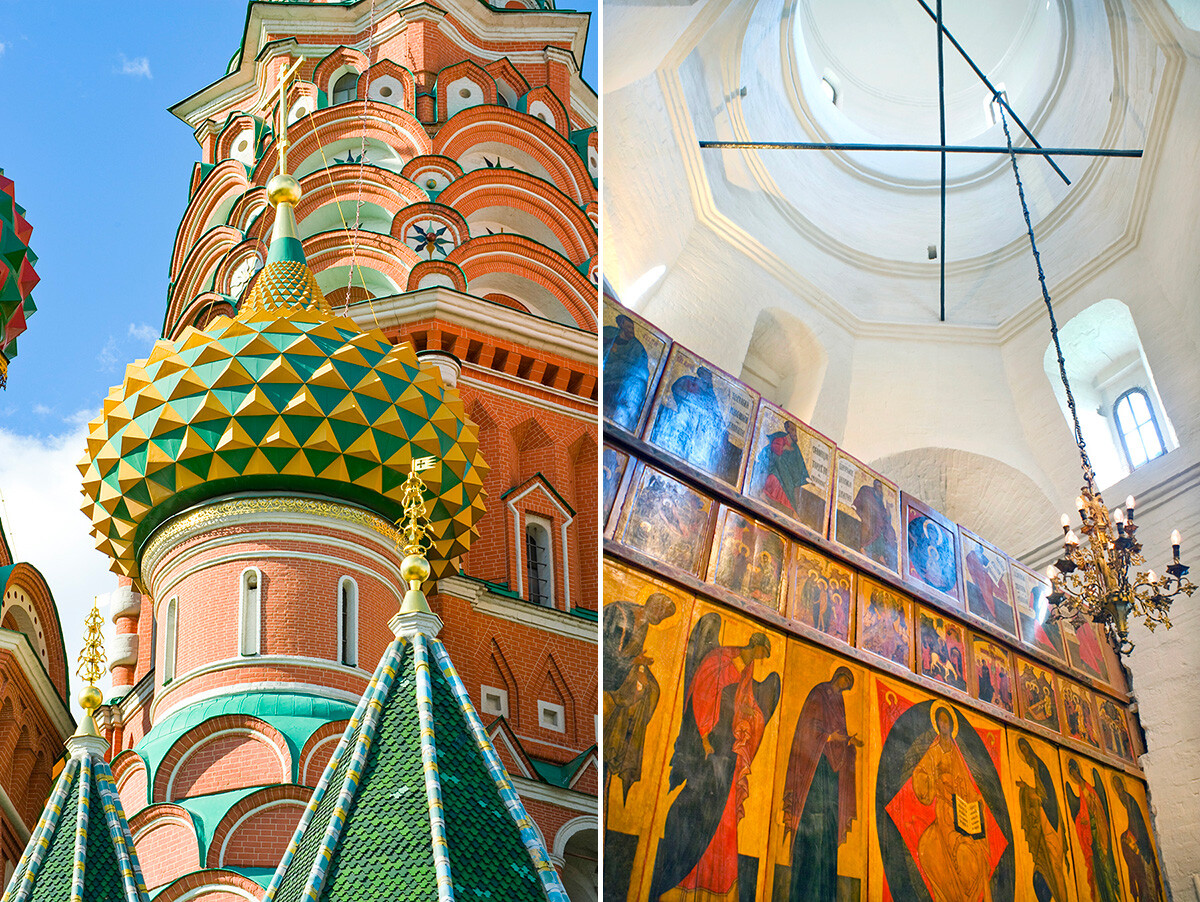
Left: St. Basil's. Church of St. Varlaam Khutinsky, southwest view. May 26, 2012. Right: St. Basil's. Church of St. Varlaam Khutinsky. Interior with icon screen. June 2, 2012.
The new construction had a dual purpose – to express the triumph of Orthodoxy and of Muscovy. Ivan’s victories were not simply an episode in interminable border warfare, but a defining event in the identity of a nation endowed with a sense of destiny.
To celebrate these ideas, each component of the cathedral was endowed with iconographic and symbolic meanings. Composed of churches grouped around a central tower, this monument has served as a symbol of unifying power since its completion in the mid-16th century.
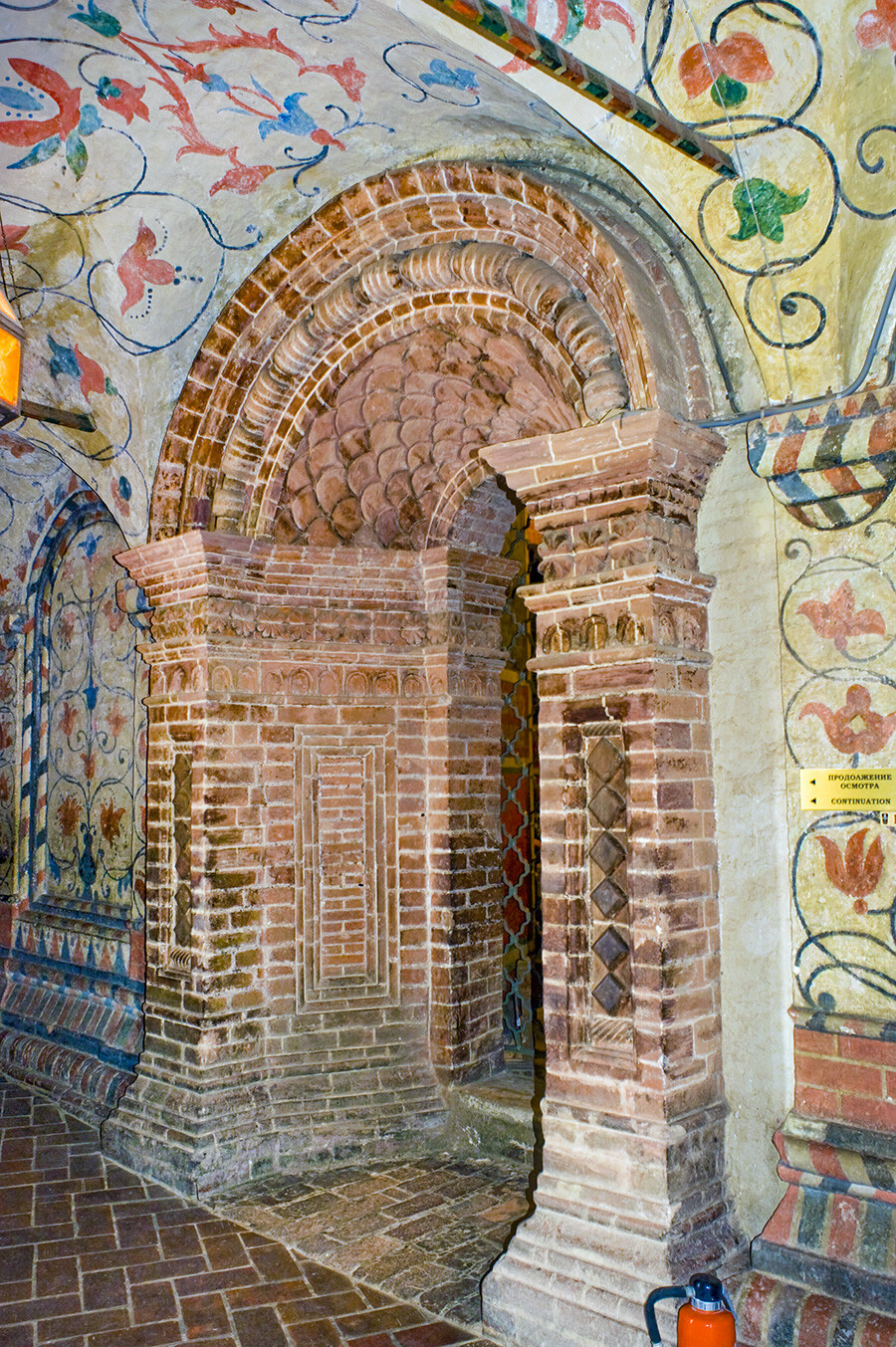
St. Basil's. Church of the Intercession, south portal. June 2, 2012.
The Intercession Cathedral ensemble (St. Basil’s) consists of a central tower surrounded by eight free-standing churches on a common terrace that was enclosed and painted in the 17th century. The plan of the ensemble embodies the trinitarian concept: each axis, diagonal and side has three towers, and the structure on the terrace level is divided into three parts.
On the interior, the plan creates an enchanting maze of decorated portals and low passageways that link the compact towers of the individual churches. Each of these spaces can accommodate only a few worshippers, and services at the temple complex were often held outdoors on an adjacent part of Red Square.
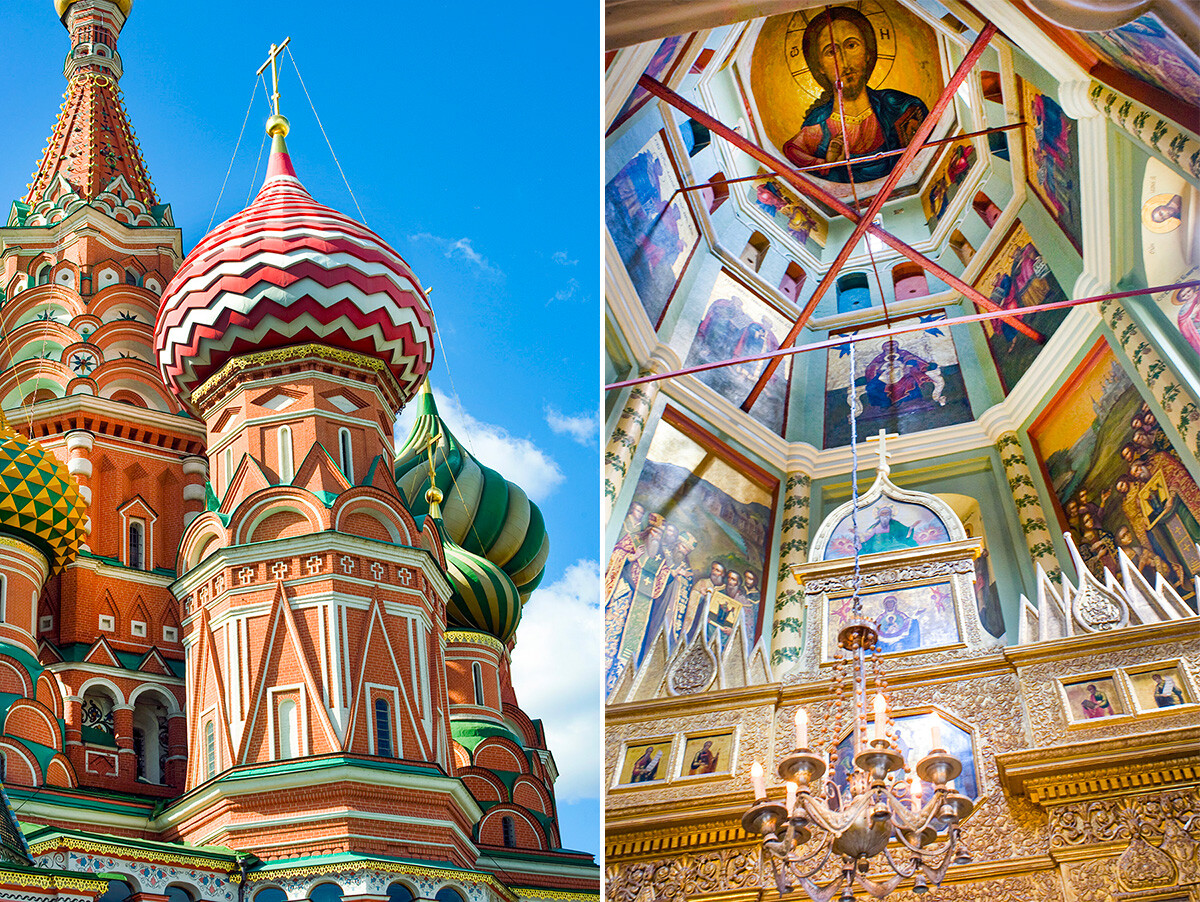
Left: St. Basil's. Church of the Velikoretsky Icon of St. Nicholas, southwest view. May 26, 2012. Right: St. Basil's. Church of the Velikoretsky Icon of St. Nicholas, interior. View of tower with upper tier of icon screen. June 2, 2012
My preceding article examined the five tower churches on the west, center, and north together with the connection. This one will survey the remaining five, including the small shrine that was dedicated to Basil himself.
An exploration of the interior begins with the main entrance gallery, located on the west side with flanking stairways (capped with pitched roofs that leads to the elevated terrace connecting the component churches. Originally open, the terrace was enclosed during a renovation of the ensemble in the 1680s. Although tightly constrained, the gallery has a festive appearance with elaborate decorative motifs painted in phases during the 18th and early 19th centuries.
Honoring family
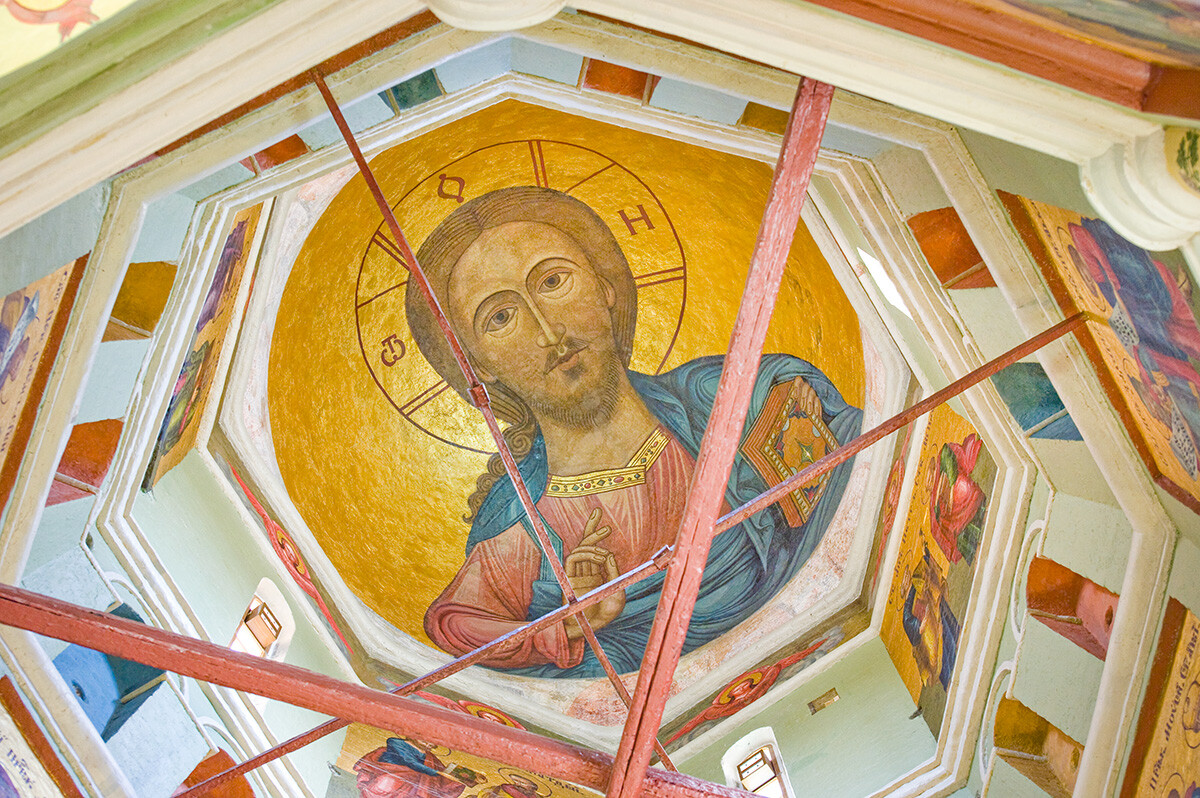
St. Basil's. Church of St. Nicholas Velikoretsky, interior. View of upper tower & dome with image of Christ Pantocrator. June 2, 2012
Two churches on the south flank relate to Ivan and his family. The dedication of the southwest church to St. Varlaam of the Khutynskii Monastery near Novgorod commemorates
Ivan's father, Basil III, who shortly before his death assumed the traditional role of monk and adopted the name Varlaam. The tower interior is of unadorned, whitewashed brick. The small, exquisite icon screen was renovated in the 18th century, yet the icons show an earlier style.
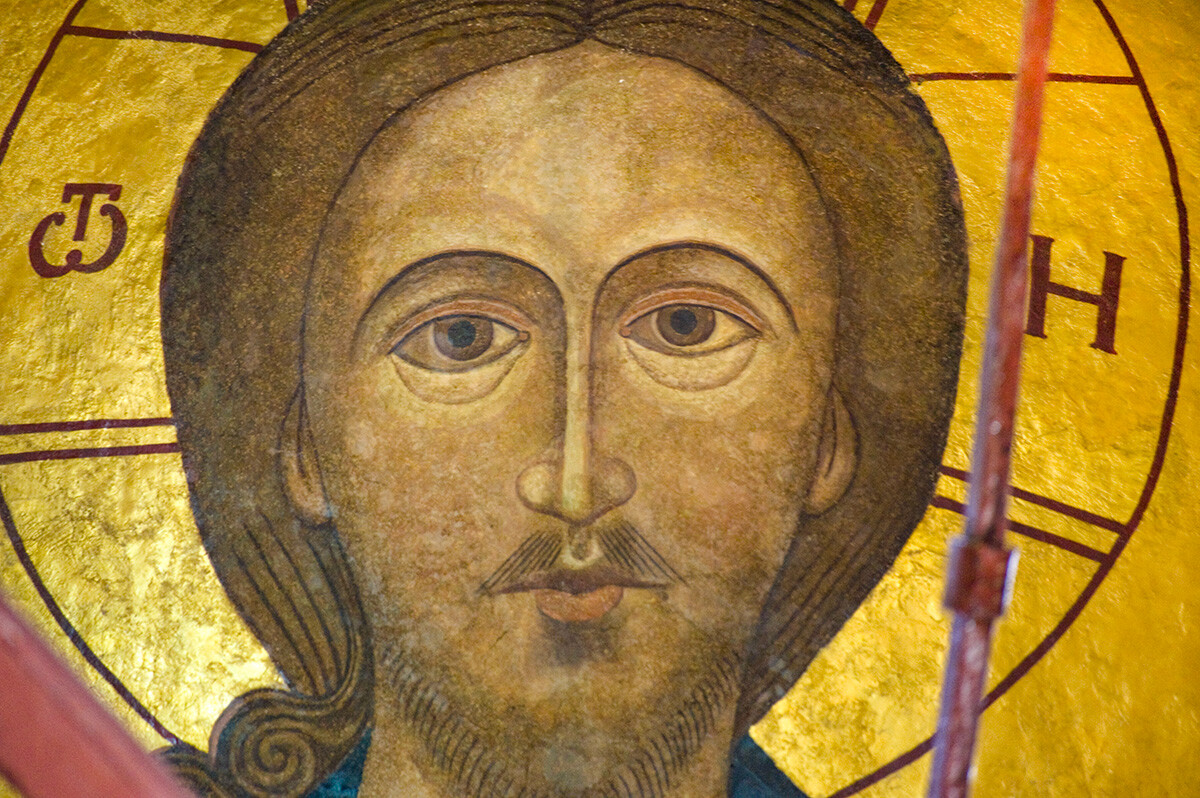
St. Basil's. Church of St. Nicholas Velikoretsky, interior. Image of Christ Pantocrator. June 2, 2012.
The south church (one of the four major towers at the points of the compass) is dedicated to the icon of St. Nicholas of Velikoretsk, a “wonder-working” icon brought to Moscow from the village of Velikoretskoe (near Vyatka) at Ivan’s command in 1555. Originally placed in the Dormition Cathedral , many miracles were attributed to the icon. It also can be seen as having a dual symbolic reference to the River Velikaya near the ancient city of Pskov, whose monks played a role in articulating the mission of Muscovite authority.
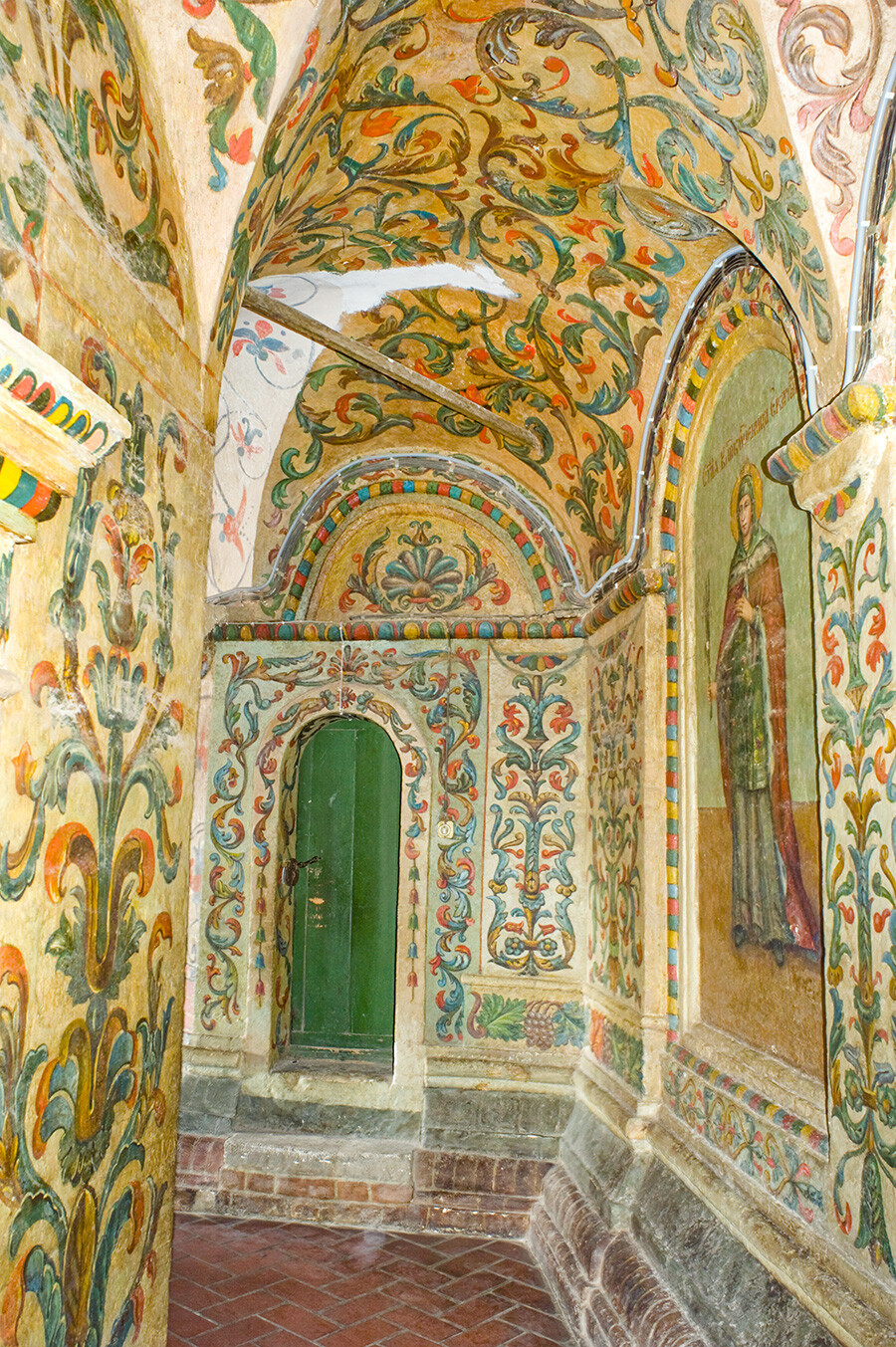
St. Basil's, interior. South gallery passage with 18th-century wall paintings. Left: painting of St. Catherine. June 2, 2012.
Like the interior of the north tower, the interior of the St. Nicholas Church was lavishly repainted with religious images in the mid-19th century. The culminating point is a youthful image of Christ Pantocrator on the dome vault. The icon screen was renovated in the mid 19th century.
Walls like brick
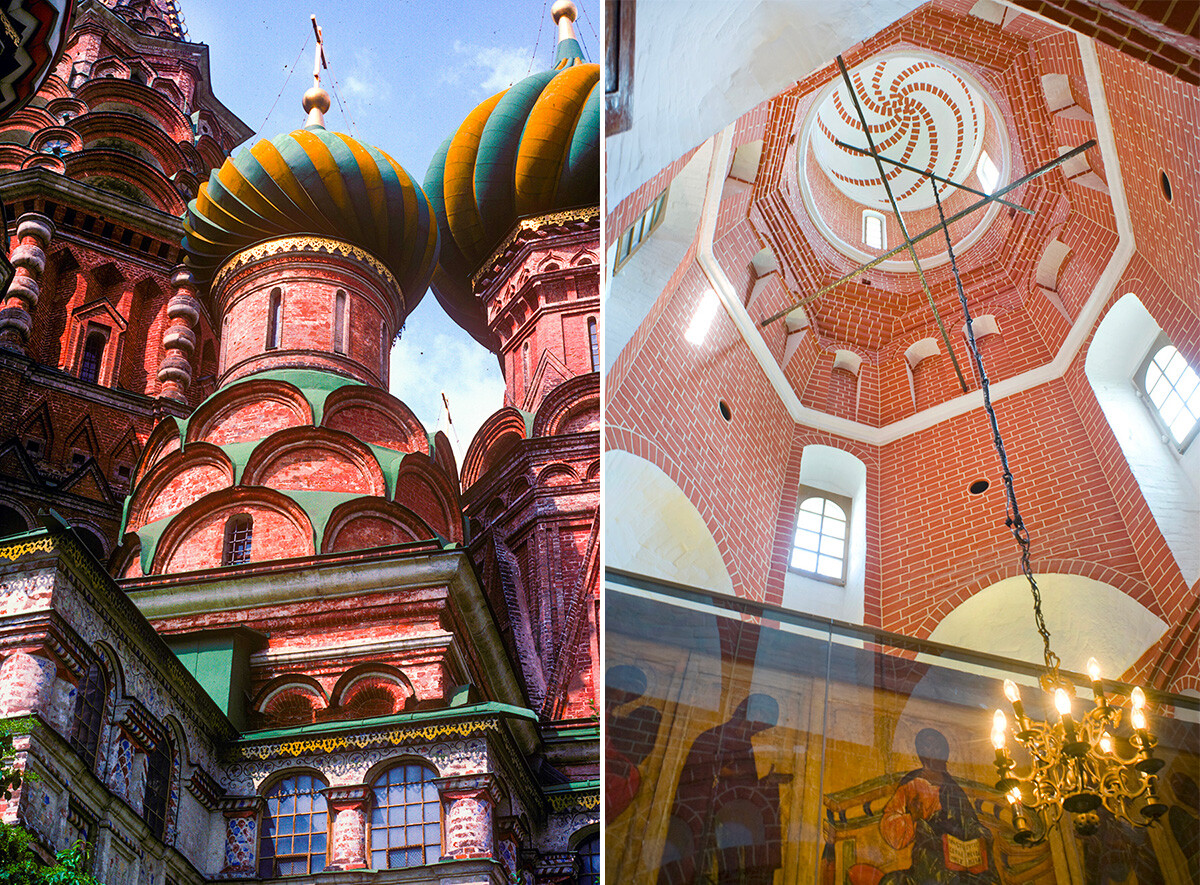
Left: St. Basil's. Church of St. Alexander of Svir, southwest view. August 5, 1994. Rigth: St. Basil's. Church of St. Alexander of Svir, interior. View of tower with upper tier of icon screen. June 2, 2012.
The southeast church, dedicated to St. Alexander of Svir, commemorates the Russian victory on August 30 over Tatar cavalry led by Prince Yepancha, thus eliminating a major threat to Moscow’s hold at the siege of Kazan. St. Alexander (1448-1533) was a monastic leader active in the Novgorod diocese and know for his rigorous asceticism. In 1485, he laid the foundation of what became the Alexander Svirsky Monastery, near the Svir River.
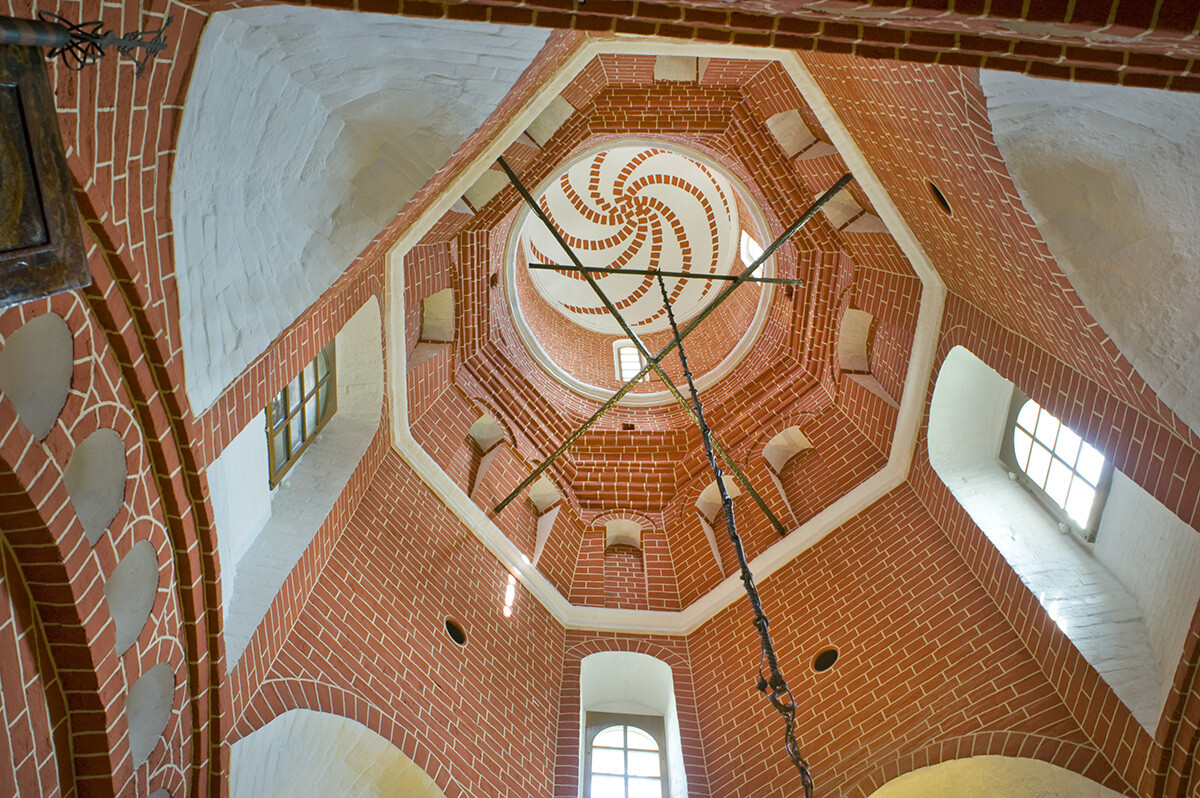
St. Basil's. Church of St. Alexander of Svir, interior. View of tower with painted bricks. June 2, 2012.
Alexander was canonized during Ivan’s reign at the initiative of Metropolitan Macarius. St. Alexander’s feastday occurs on August 30, and thus both the northeast Church of the Three Patriarchs and the southeast church symbolize the Russian victory on that day.
Although not painted with religious images, the walls of this small tower are a fascinating example of a technique known as pod kirpichi (“like brick”) in which the walls were painted brick red, with white seams limned to resemble mortar. This practice, imported from Italy, was also applied to the brick exterior of the entire ensemble in the late 18th century. The paint not only protected the walls from moisture seepage, but also enhanced the color of the surface.
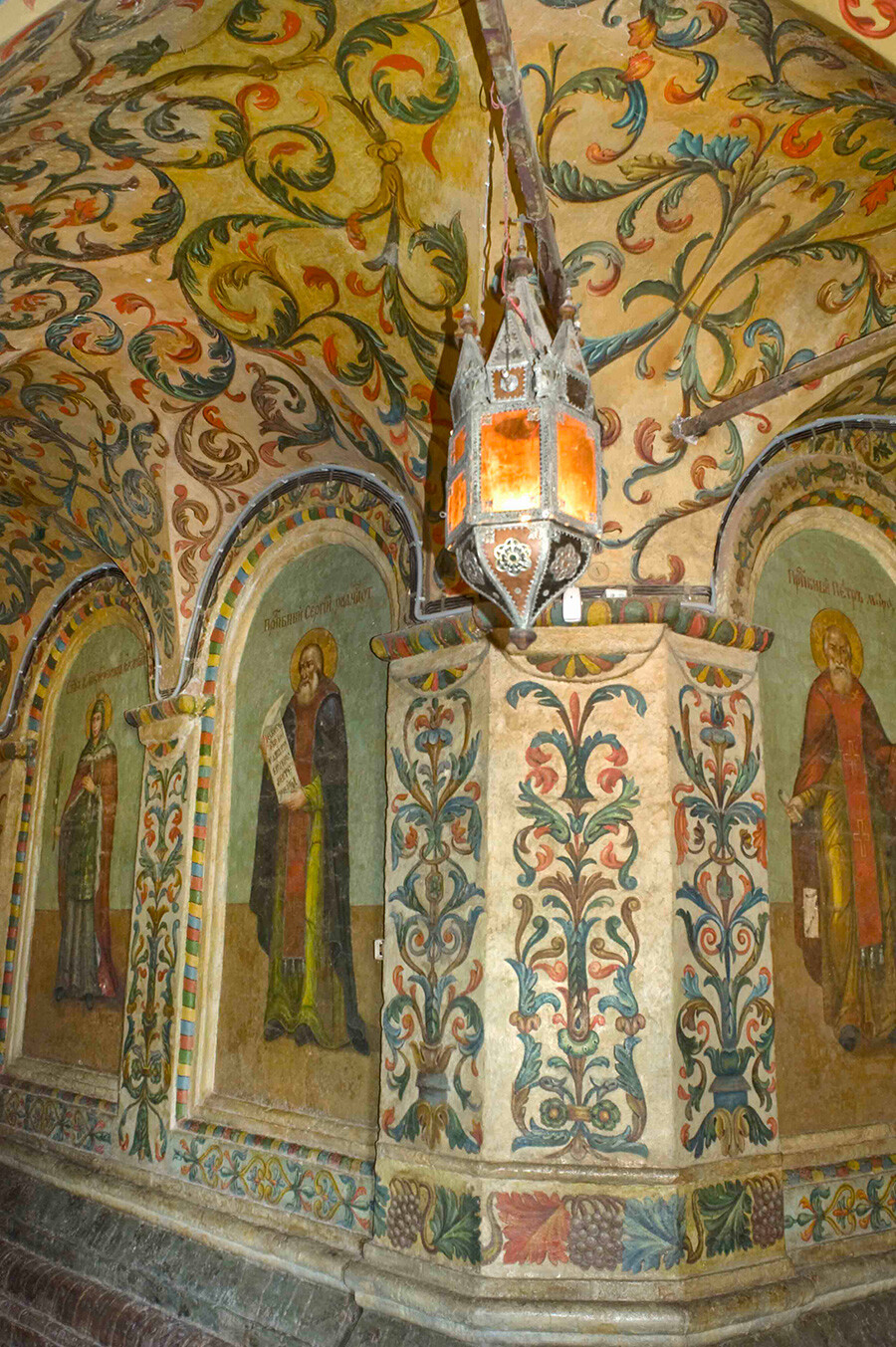
St. Basil's, interior. South gallery passage with 18th-century wall paintings. From left: St. Catherine, St. Sergius of Radonezh, Metropolitan Peter. June 2, 2012.
The main axis concludes on its eastern end with the major tower dedicated to the Trinity. This church is the holy of holies for the ensemble by virtue of its dedication to the trinitarian concept, which forms the numerological system of the cathedral. The sole decorative element on the whitewashed interior walls is a brick spiral on the vault of the dome. The icon screen was renovated in the 18th century.
Why St. Basil’s?
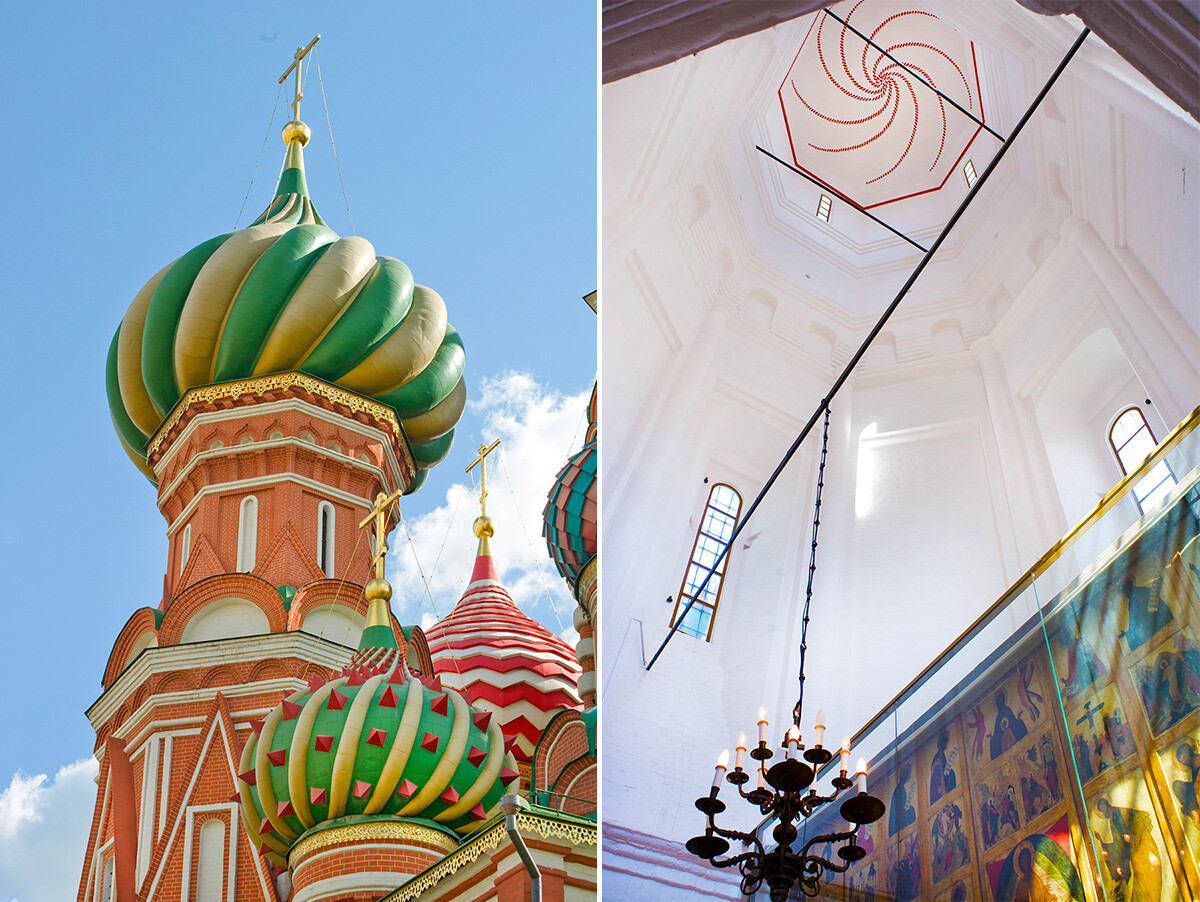
Left: St. Basil's. Church of the Trinity, north view. Lower center: Dome of Church of Basil the Blessed. May 26, 2012. Right: St. Basil's. Church of the Trinity, interior. Tower with icon screen & decorative brick spiral in dome. June 2, 2012.
When all the original churches are accounted for, there is still the popular name of the temple –St. Basil’s. Basil the Blessed (1469-1552 or 1557) was a Muscovite yurodivy — or "fool in Christ" — revered by the tsar himself as well as by the common people for his saintliness and gift of prophecy. With the support of Metropolitan Macarius, a wooden shrine in his honor of Basil (Vasily Blazhenny) was erected to the east of the original Trinity Church.
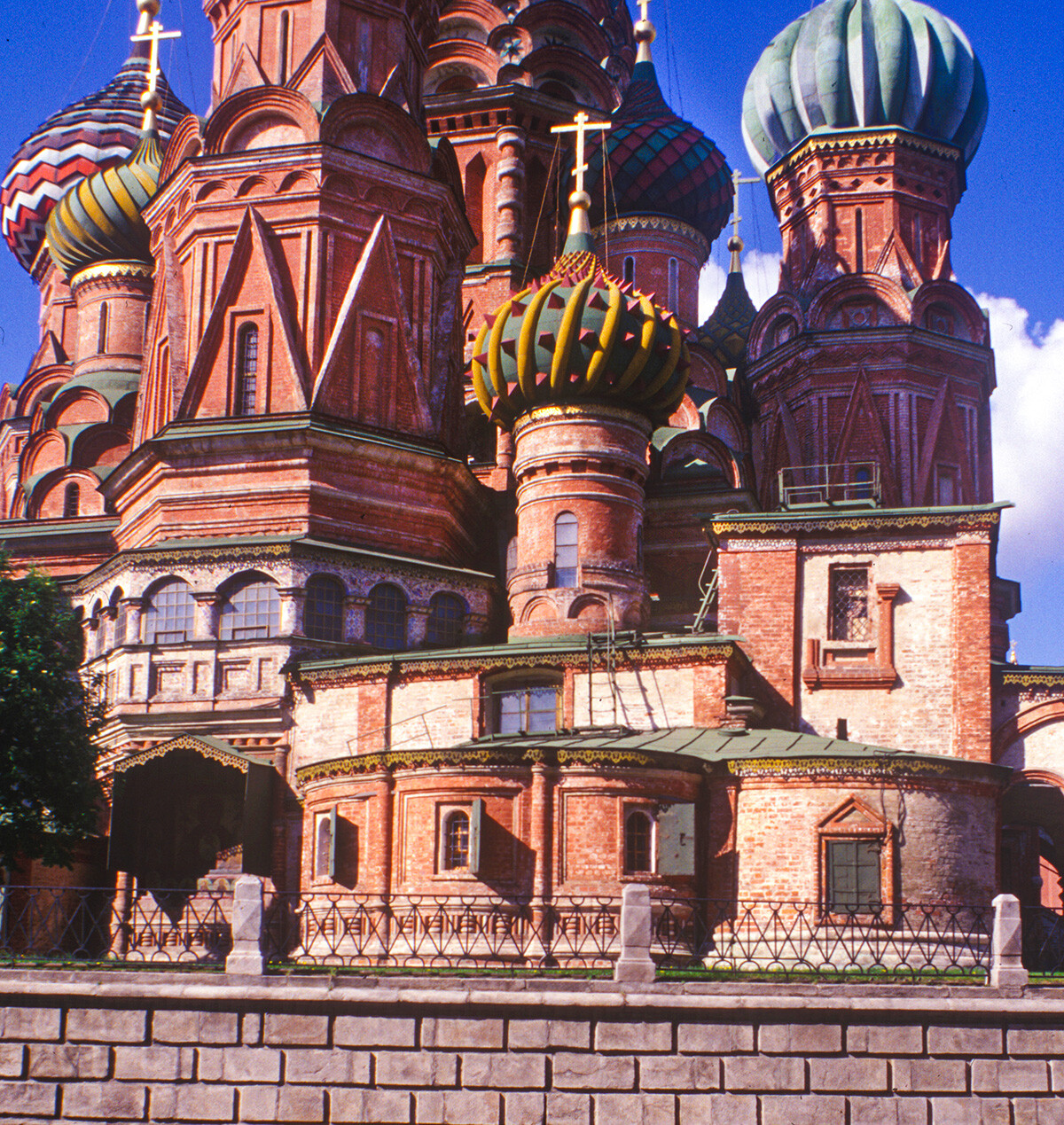
St. Basil's, northeast view. From left center: Trinity Church, Church of Basil the Blessed, Church of the Three Patriarchs (in shadow), Church of Sts. Cyprian & Justina. Background: Tower of Church of the Intercession. East view. August 6, 1987.
The shrine was maintained during the building of the Intercession Cathedral. Basil’s official veneration took place in 1588, during the reign of Ivan’s son Feodor and with the support of Boris Godunov). At that time, a small brick Church of Basil the Blessed was attached to the northeast corner of the cathedral. Renovated in 1672, its architecture retains archaic features of the 16th century. The small interior is dominated by a lavish icon screen and by the sarcophagus of Basil.
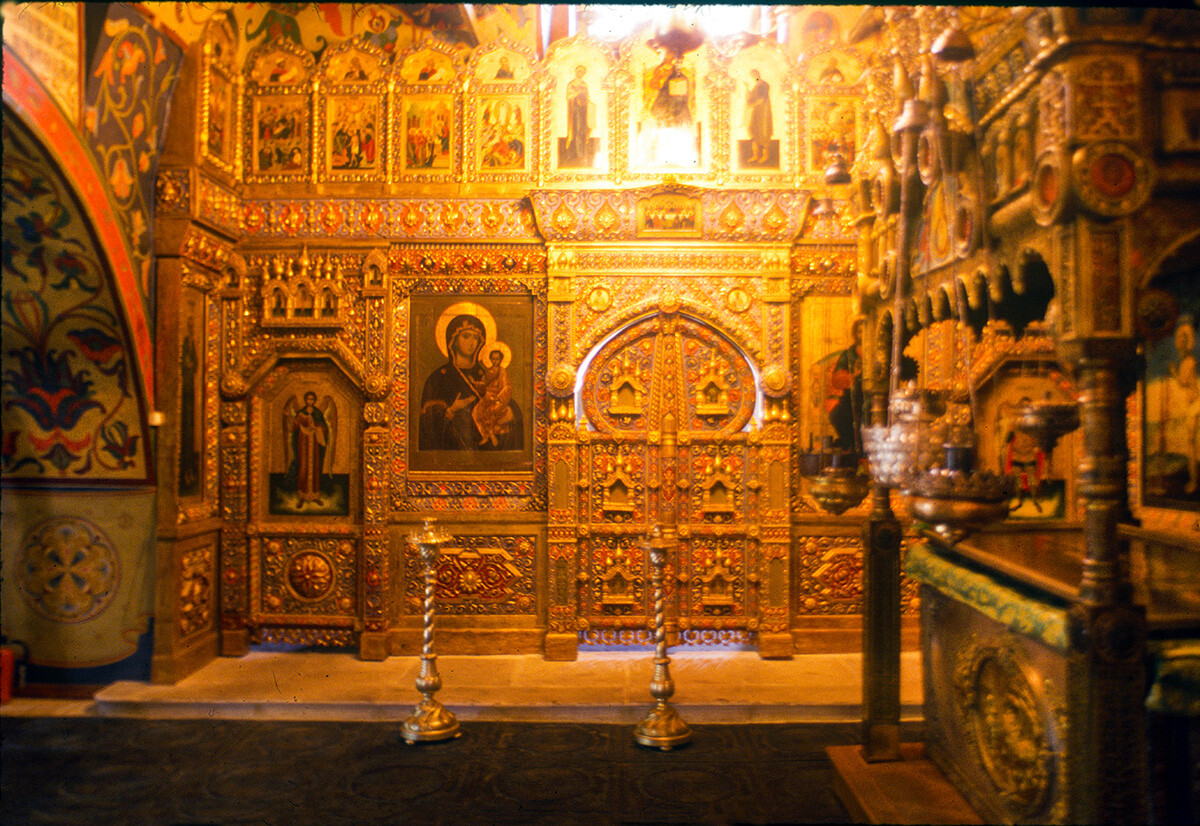
St. Basil's. Church of Basil the Blessed, interior. View east toward icon screen. Right: Sarcophagus of Basil the Blessed. June 21, 1994.
The Church of Basil the Blessed also became the resting place of another “fool in Christ,” Blessed John — popularly known as “the big cap” (Bolshoy kolpak ) — who before his death in 1589 expressed the desire to be buried near Basil the Blessed.
Despite the modest size of the church in relation to the surrounding towers, the cult of Basil grew to usurp in common usage all the cathedral's previous designations, official or unofficial. Indeed, it was the only part of the ensemble that held liturgical services daily. Services at the other churches were held only on their dedicatory day and on the 12 major feastdays.
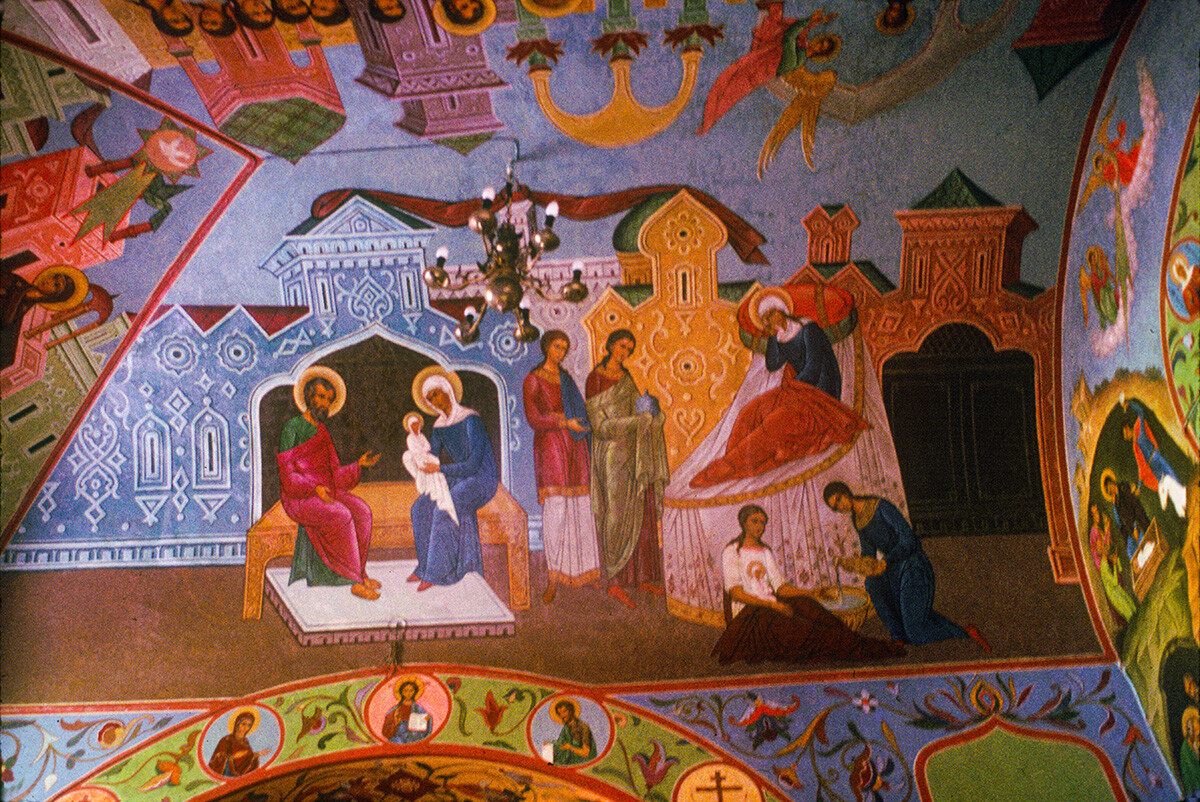
St. Basil's. Ground level passage to Church of Basil the Blessed. Ceiling painting of Nativity of the Virgin at Nativity Altar near grave of John the Blessed. June 21, 1994.
More could be written about the layers of symbolic richness displayed in St. Basil’s, a richness that has evolved over the centuries since its original construction. The Intercession Church itself has become an icon of Russia, a complement to the Kremlin as a statement of national identity.
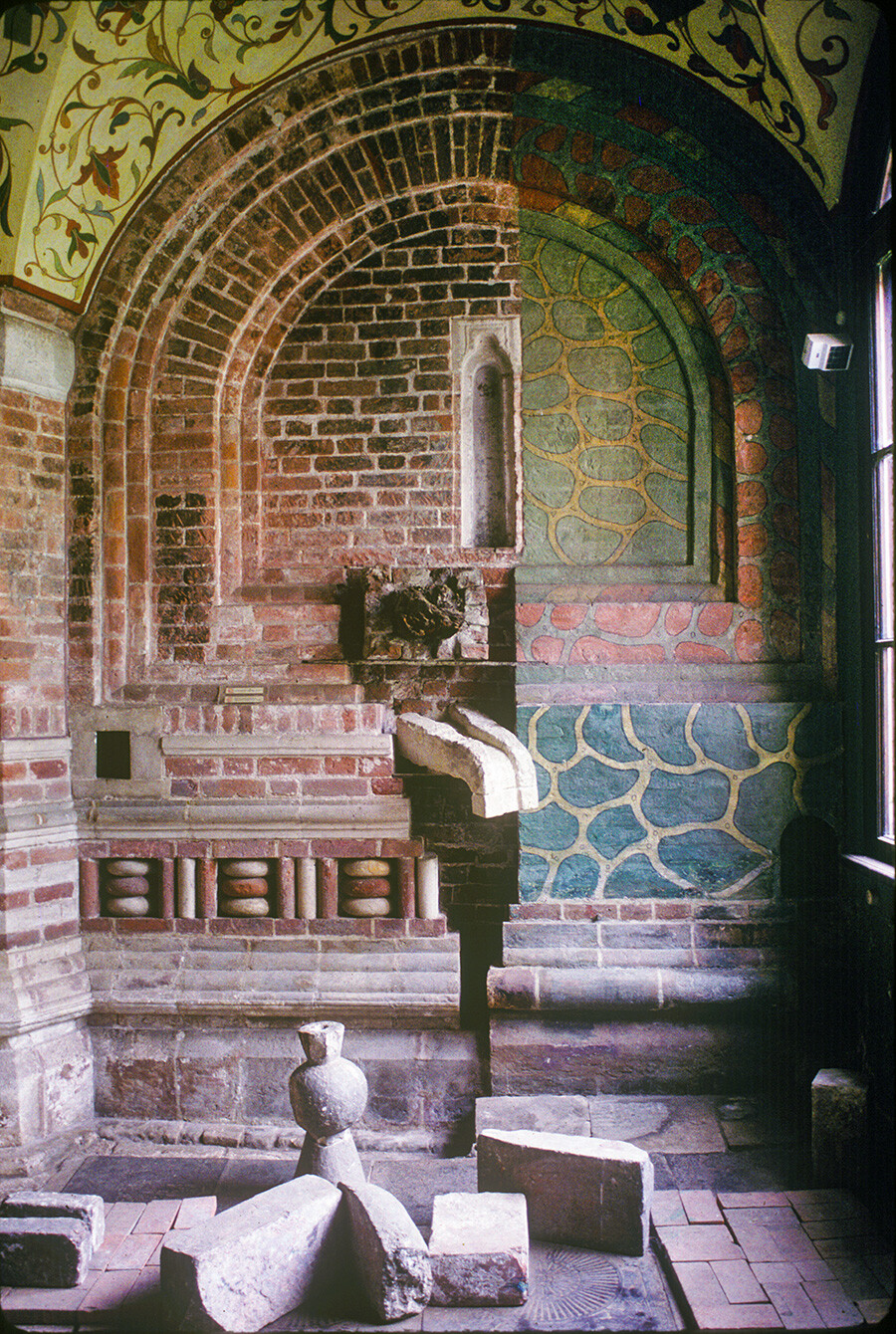
St. Basil's. Ground level passage with display of construction artifacts & different layers of wall decoration from 16th- 19th centuries. June 21, 1994.
In the early 20th century, the Russian photographer Sergey Prokudin-Gorsky developed a complex process for color photography. Between 1903 and 1916 he traveled through the Russian Empire and took over 2,000 photographs with the process, which involved three exposures on a glass plate. In August 1918, he left Russia and ultimately resettled in France where he was reunited with a large part of his collection of glass negatives, as well as 13 albums of contact prints. After his death in Paris in 1944, his heirs sold the collection to the Library of Congress. In the early 21st century the Library digitized the Prokudin-Gorsky Collection and made it freely available to the global public. A few Russian websites now have versions of the collection. In 1986 the architectural historian and photographer William Brumfield organized the first exhibit of Prokudin-Gorsky photographs at the Library of Congress. Over a period of work in Russia beginning in 1970, Brumfield has photographed most of the sites visited by Prokudin-Gorsky. This series of articles juxtaposes Prokudin-Gorsky’s views of architectural monuments with photographs taken by Brumfield decades later.
If using any of Russia Beyond's content, partly or in full, always provide an active hyperlink to the original material.
to our newsletter!
Get the week's best stories straight to your inbox
- U.S. professor continues photographic legacy of Prokudin-Gorsky in new book
- The Dormition Cathedral: Regal monument in the Kremlin
- Exploring the mysterious interior of St. Basil's
This website uses cookies. Click here to find out more.

World 🢖 Europe 🢖 Russia 🢖 Moscow
Churches 🢔 Religious architecture 🢔 Architectural wonders 🢔 Categories of wonders
Saint Basil’s Cathedral, Moscow
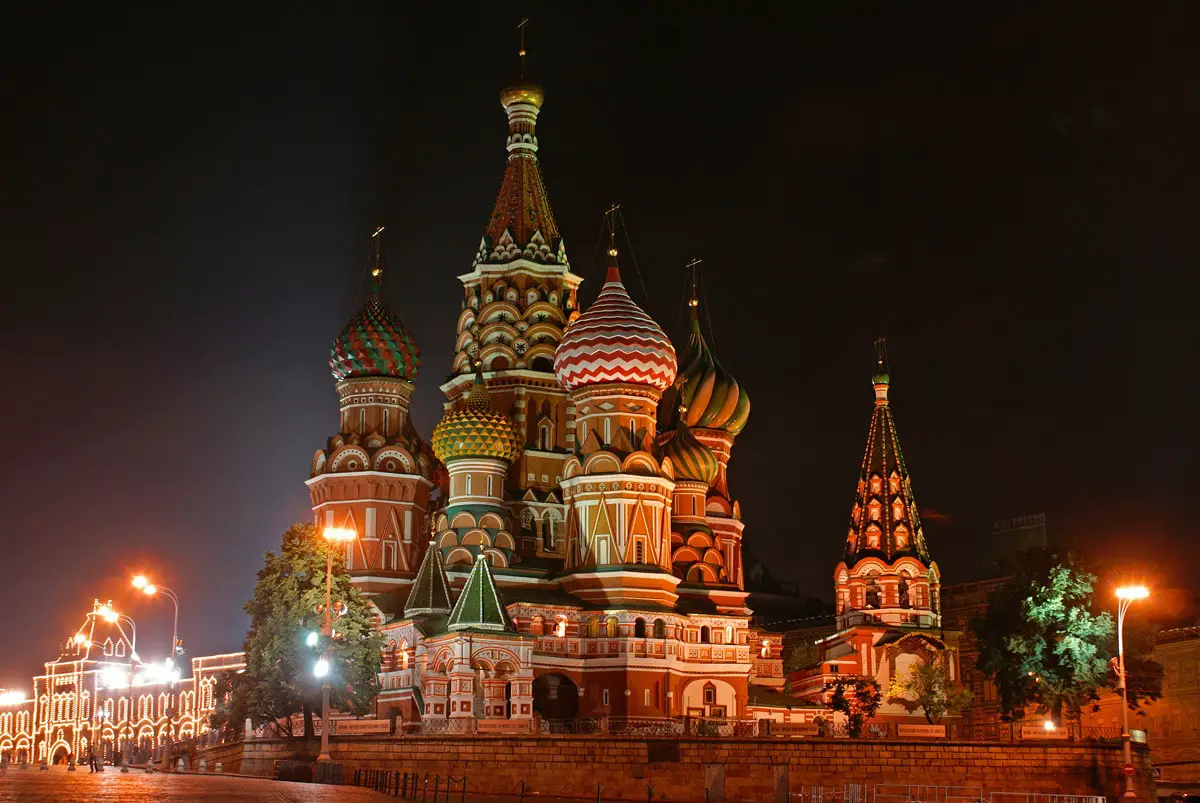
O ne of the visually most surprising buildings in the world is Saint Basil’s Cathedral in Moscow, Russia. This amazing church was built 450 years ago next to the Moscow Kremlin.

GPS coordinates
Location, address, alternate names, name in russian, year of construction, architectural style, branch of christianity, unesco world heritage status, map of the site, ivan the terrible and his victories.
The history of Saint Basil’s Cathedral was started by Ivan the Terrible – the tsar of Russia who reigned in 1533 – 1584. In his time the area governed from Moscow expanded mainly in southern and eastern directions, reaching the Caspian Sea and stepping over the Urals into Western Siberia.
Troops of Ivan the Terrible won many significant victories and one of the most important was the capture of Kazan in 1552.
1555 – 1561: Stone churches are built
In 1555 Ivan the Terrible ordered to rebuild the churches.
There were built new stone churches in the site of Trinity Church and surrounding eight wooden churches – Church of Trinity was consecrated on 12 July 1561.
According to the popular tradition, the architects of this amazing structure were Barma and Postnik Yakovlev.
Now many researchers consider that this was one person, an artisan from Pskov.
Legend tells that Ivan the Terrible ordered to pierce the eyes of the architect so that nothing similar is built elsewhere. Such conduct might be in the style of Ivan the Terrible, but it seems that legend was not correct this time. The name of Postnik appears in connection with some more beautiful Russian churches elsewhere (also Kazan Kremlin), constructed in later times.
1561 – 1683: “Jerusalem Temple”
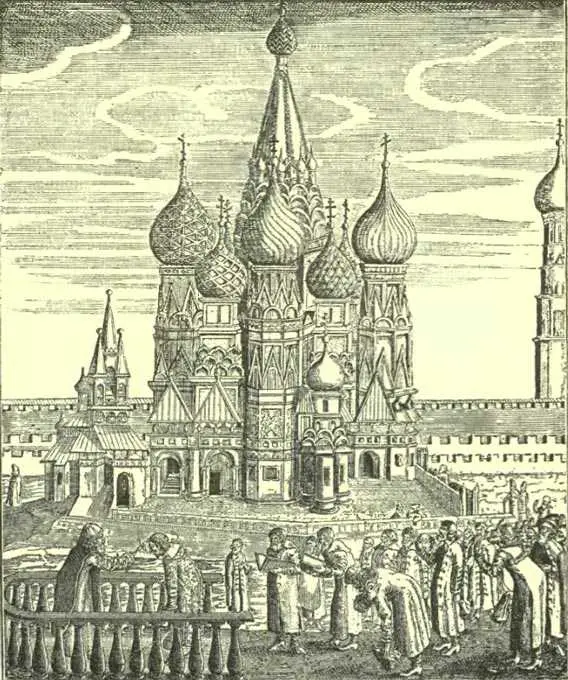
Saint Basil’s Cathedral was by all accounts a very impressive and very well known building. The central church – Trinity Church, for example, was the tallest structure in Moscow until 1600 when Ivan the Great Bell Tower inside the Kremlin was raised up to its present height – 81 m.
The church gained high importance in the life of the city. The dense group of nine churches resembled a mythical citadel and was called “Jerusalem”. The structure served indeed as an allegory of the Jerusalem Temple in the annual parade, which was attended by the Patriarch of Moscow and the tsar.
As the years passed, the church experienced numerous rebuildings.
In 1588 there was added one more church to the complex – the tenth one.
In 1583 there burned down the Trinity church – it was rebuilt in 1593.
In 1680 – 1683 the former complex of ten churches was united by a ground floor. The newly built galleries were adorned with frescoes – rich floral ornamentation.
1683 – 1918: wars and restoration works
In 1737 the church suffered from a fire.
There were done extensive repairs in 1761 – 1784 when the walls of the first two floors were adorned with frescoes.
The church was looted in 1812 by the French troops. Napoleon wanted to destroy it but happily, it did not happen.
The cathedral was restored back to its former glory in 1816.
More restoration works were carried out in 1896 – 1909.
Outstanding personality was the last keeper of the cathedral from the Orthodox church – Ivan Vostorgov . This socially active, tireless clergyman was executed by Bolsheviks in 1918.
Bolsheviks and museum
Bolsheviks initially were obsessed with an idea to demolish Saint Basil’s Cathedral. In 1933 it was even removed from the heritage register in order to start the demolition, but happily, the mood of Soviet leaders soon changed and the value of the church was recognized. Since then here several times were performed repair works.
During the Soviet times, the cathedral was seized from the Russian Orthodox community and was used as a branch of the State Historical Museum since 1928. It remains the property of the Russian Federation up to this day. Since 1991 there was renewed church service.
In 1957 – 1961 there took place meticulous work to remove the oil layers, painted in the 18th century over the old frescoes. The multiple layers of frescoes pose a challenge to restorers – it is not always clear which one of these is the one to be exposed to.
Nowadays the cathedral is one of the symbols of world architecture, a very popular landmark.
It has been noted though that the building has an adverse impact from another important Russian tradition – the military parades on Red Square. The heavy tanks and jet fighters create cracks in the walls of the cathedral.
The architecture of Saint Basil’s Cathedral
Style and influence.
There has been no similar building built before or after. The complexity and amazing mix of details have no analogs in Russian architecture. It has left a huge impact on the development of Russian national architecture.
Some researchers speculate that this design has its roots in Byzantine and Muslim architecture, some – that it has been influenced by the wooden vernacular architecture. It is also seen as an expression of a specific, indigenous Russian Renaissance style. There might be much truth in this, especially if we note that there were working Italian and Greek artisans in this time in Russia, bringing new thinking with them.
Some art historians consider, that the planning of such a complex of closely located churches was inspired by the Quolsharif Mosque in Kazan. This once beautiful structure was destroyed, when Russian troops invaded Kazan. It is also known that the same builders, who built Saint Basil’s Cathedral, worked also in Kazan and could bring new influence from there.
The cathedral was built in the geographical center of Moscow City – the city developed around this location since the 14th century. Cathedral is located close to the Kremlin, but outside it. Originally here was located a busy marketplace.
Saint Basil’s Cathedral is shaped like flames in a bonfire.
The building consists of a central church with eight side churches.
Central church and four surrounding churches are octagonal in plan. The four diagonally placed churches are cuboids.
The eight smaller churches are placed in a symmetrical circle, while the central church is offset to the west to accommodate its apse. Eight side churches have onion domes, while the central one has a low spire with a smaller onion dome over it. In total there are 10 cupolas. Onion domes were added at the end of the 16th century.
Linked articles
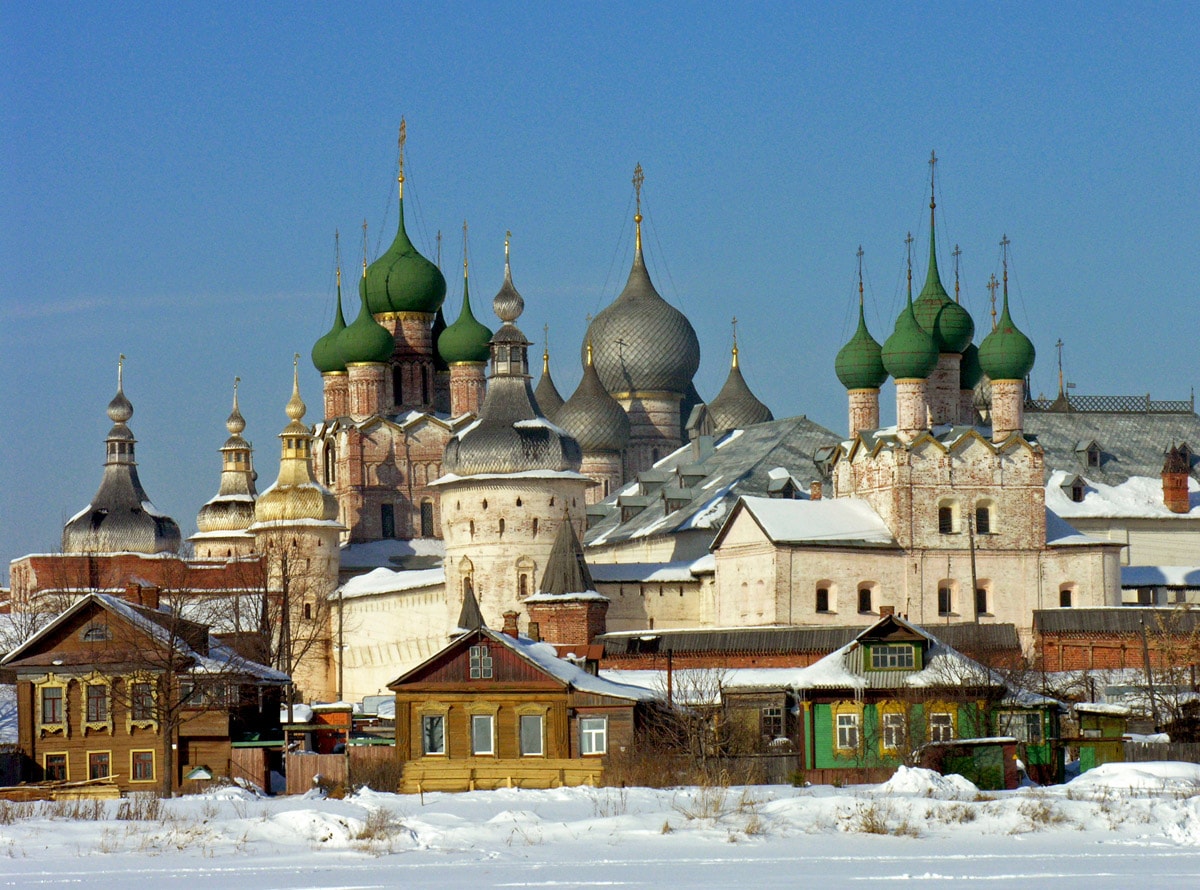
Wonders of Russia
The largest country in the world, Russia, is associated in the minds of many people with the onion domes of Orthodox churches and the massive walls of the Moscow Kremlin. But besides the unique architecture, Russia offers many more unusual and exciting attractions.
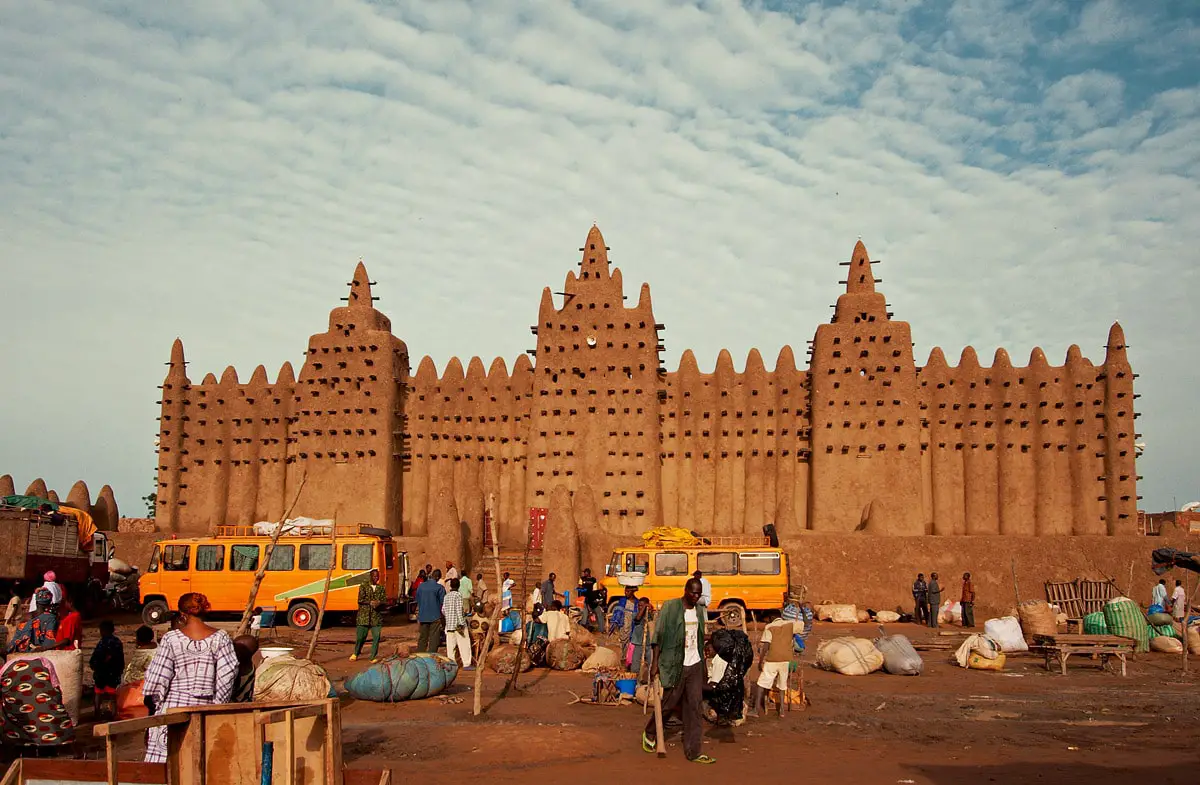
Religious architecture
Since ancient times human talents and skills have been expressed in religious architecture and arts, and traditions and rituals have evolved around pilgrimage sites. Religious buildings represent a major part of the highest achievements in architecture and crafts.
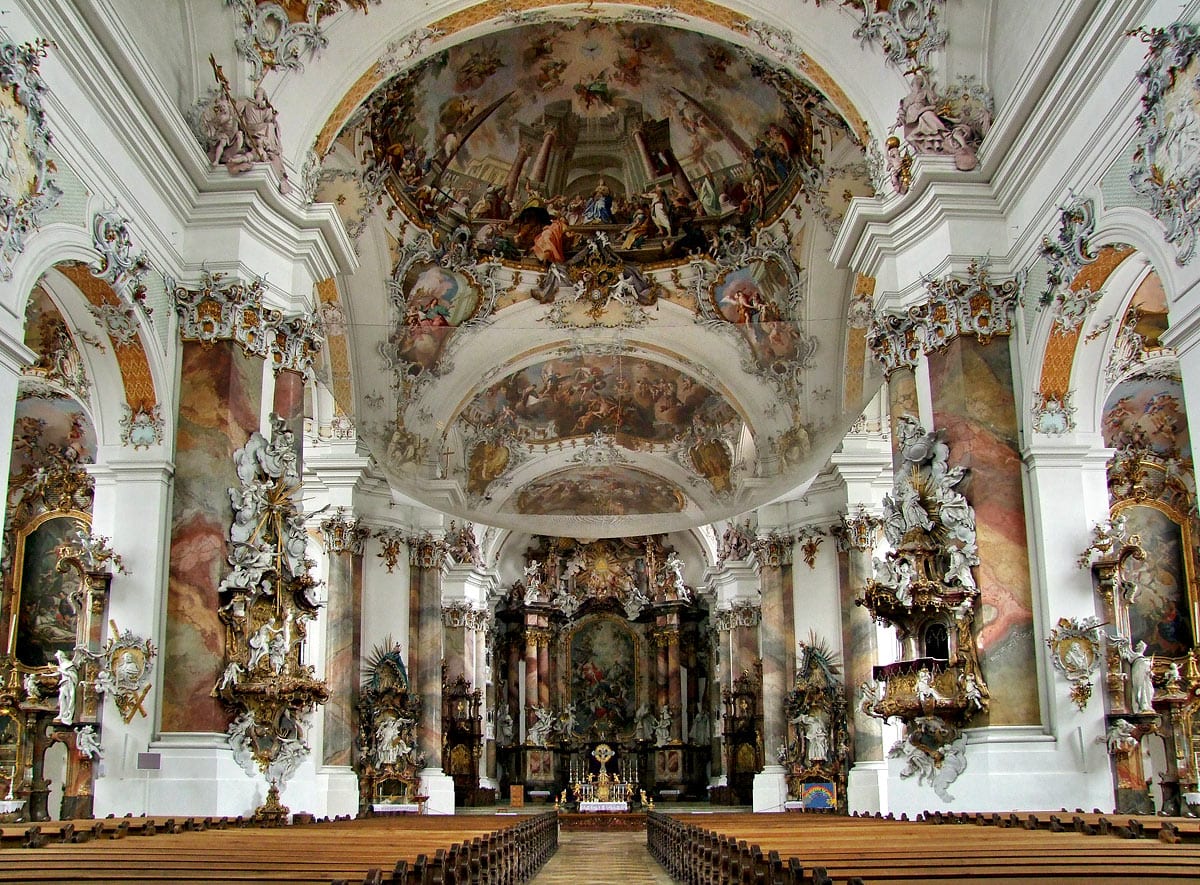
Throughout the millennia Christian churches have been the epitome of architecture and arts achievements in Western culture.
Recommended books
The holy place: architecture, ideology, and history in russia.

This book surveys two centuries of Russian history through a succession of ambitious architectural projects designed for a single construction site in central Moscow. Czars, Bolshevik rulers, and contemporary Russian leaders alike have dreamed of glorious monuments to themselves and their ideologies on this site. The history of their efforts reflects the story of the nation itself and its repeated attempts to construct or reconstruct its identity and to repudiate or resuscitate emblems of the past.
Saint Basil’s Cathedral: History and Architecture of Moscow’s Greatest Church

St. Basil’s Cathedral also called “The Cathedral of the Protection of the Most Holy Theotokos on the Moat,” or the “Temple of Saint Basil the Blessed,” is an Eastern Orthodox Church in Moscow, Russia. The cathedral is a popular search on Wikipedia not only because it is a marvel of architecture, but because it serves as an important edifice for Orthodox Christians around the world.

IMAGES
VIDEO
COMMENTS
"Sacred Ground" is the 49th episode of Star Trek: Voyager, the seventh episode of the third season. In this episode a crew member of the star ship Voyager is injured by an energy field in an alien temple.. This science fiction television episode, part of the Star Trek franchise, was broadcast on UPN on October 30, 1996.. This episode is noted as one of the shows directed by a major actor in ...
Sacred Ground: Directed by Robert Duncan McNeill. With Kate Mulgrew, Robert Beltran, Roxann Dawson, Jennifer Lien. After Kes is injured by an energy field on a planet's sacred ground, Janeway must undergo a spiritual quest in order to save her life.
Kes is injured when she accidentally commits sacrilege on an alien planet; in order to save her life, Janeway must go through a mysterious ritual that challenges her faith in science. "Captain's log, stardate 50063.2. We've accepted an invitation from the Nechani to take a few days shore leave on their world. We're enjoying the opportunity to learn about their culture." The crew of the USS ...
"Star Trek: Voyager" Sacred Ground (TV Episode 1996) cast and crew credits, including actors, actresses, directors, writers and more. Menu. Movies. Release Calendar Top 250 Movies Most Popular Movies Browse Movies by Genre Top Box Office Showtimes & Tickets Movie News India Movie Spotlight.
Star Trek: Voyager "Sacred Ground" ... (the most spiritual ST character next to Major Kira, IMO) would be on the side of scientific reason. Even early in the episode he seemed to have more of an open mind about the possibility of there being real spirits on the planet. But Janeway's life appeared to be at risk and I can see where that would ...
Sacred Ground. On an alien planet, Kes, a crew member of the USS Voyager, finds herself in a precarious situation when she enters a sacred temple to receive a healing ritual to save her life. After she's refused entry, the Voyager's Captain Janeway is forced to intervene and attempts to negotiate a peaceful solution.
This episode is noted as one of the shows directed by a major actor in the show, Robert Duncan McNeill, who also plays the character Tom Paris. "Sacred Ground" is the 49th episode of Star Trek: Voyager, the seventh episode of the third season. In this episode a crew member of the star ship Voyager is injured by an energy field in an alien temple.
Star Trek Voyager S 3 E 7 "Sacred Ground". While exploring the catacombs of a deeply religious civilization, Kes is zapped by a lethal force field, and Janeway must undergo a ritual to petition the peoples' religious figures to spare her life...
Kes accidentally intrudes on a religious shrine and is almost killed by a strange energy beam. Told there is nothing that can medically be done to save her, Captain Janeway undergoes a spiritual quest to ask the "spirits" to spare Kes's life.
Episode Guide for Star Trek: Voyager 3x07: Sacred Ground. Episode summary, trailer and screencaps; guest stars and main cast list; and more.
Sacred Ground is the seventh episode of the third season of Star Trek: Voyager, and the forty-ninth episode overall. Starring: Guest Starring: Becky Ann Baker (Guide), Harry Groener (Magistrate), Estelle Harris (Old Woman), Keene Curtis (Old Man #1), Parley Baer (Old Man #2)
Sacred Ground (1996) ← Back to episode. Remember (3x6) Future's End (1) (3x8) Season Regulars 9. Kate Mulgrew. Kathryn Janeway Robert Picardo. The Doctor Roxann Dawson. B'Elanna Torres Jennifer Lien. Kes Tim Russ. Tuvok Garrett Wang. Harry Kim Robert Duncan McNeill ...
Kes accidentally intrudes on a religious shrine and is almost killed by a strange energy beam. Told there is nothing that can medically be done to sav…
Juliette Harrisson reviews 'Sacred Ground,' an episode of 'Star Trek: Voyager' and possibly the only Star Trek episode about religion that doesn't annoy her. Star Trek Voyager: Sacred Ground. by Juliette "Even when her science fails right before her eyes, she still has full confidence in it. Now, there's a leap of faith." When Kes wanders into ...
Of all the Star Trek shows, "Voyager" is by far my least favorite. Much of it is because there is too much pseudo-religious mumbo-jumbo. I liked the religious elements of "Deep Space 9"--mostly because the Bajoran religion was created FOR the show.
Janeway undergoes an arduous spiritual test in order to spare Kes from death.
The biggest issue with Sacred Ground is the episode's reluctance to let Mulgrew carry the episode on her own terms. The sequences of Janeway undergoing her spiritual awakening are long and weird, utterly unlike anything the viewers have come to expect from Voyager.There is a minimal amount of tension and very little immediate threat, all giving way to abstract imagery and colourful metaphor.
Star Trek: Voyager has dabbled in Michael Piller's interest in new-age mysticism previously, but "Sacred Ground" grabs the idea by the horns and wrestles it to the altar. "Sacred Ground" is the last holdover from the second season and shares a lot of qualities with that infamous season. But it's also a Janeway vehicle that attempts ...
The Voyager Transcripts - Sacred Ground. Sacred Ground Stardate: 50063.2 Original Airdate: October 30 1996. Captain's log, stardate 50063.2. We've accepted an invitation from the Nechani to take a few days shore leave on their world. We're enjoying the opportunity to learn about their culture.
The Cathedral of Vasily the Blessed (Russian: Собо́р Васи́лия Блаже́нного, tr. Sobór Vasíliya Blazhénnogo), commonly known as Saint Basil's Cathedral, is an Orthodox church in Red Square of Moscow, and is one of the most popular cultural symbols of Russia.The building, now a museum, is officially known as the Cathedral of the Intercession of the Most Holy Theotokos ...
An 1817 map. Areas of Moscow destroyed by the fire are in red. Faber du Faur Moskau 1812. During the French occupation of the city, the 1812 Fire of Moscow persisted from 14 to 18 September 1812 and all but destroyed the city. The Russian troops and most of the remaining civilians had abandoned the city on 14 September 1812 just ahead of French Emperor Napoleon's troops entering the city after ...
The origins of St. Basil's are as complex as its form. Soon after Tsar Ivan IV (the Terrible) captured the city of Kazan on October 1-2, 1552, he commanded that a church dedicated to the Holy ...
He was buried in the site of future St. Basil's Cathedral. Saint Basil is not the only "sacred fool" buried here - also Ivan the Blessed was buried on church grounds in 1589. 1555 - 1561: Stone churches are built ... 1683 the former complex of ten churches was united by a ground floor. The newly built galleries were adorned with ...